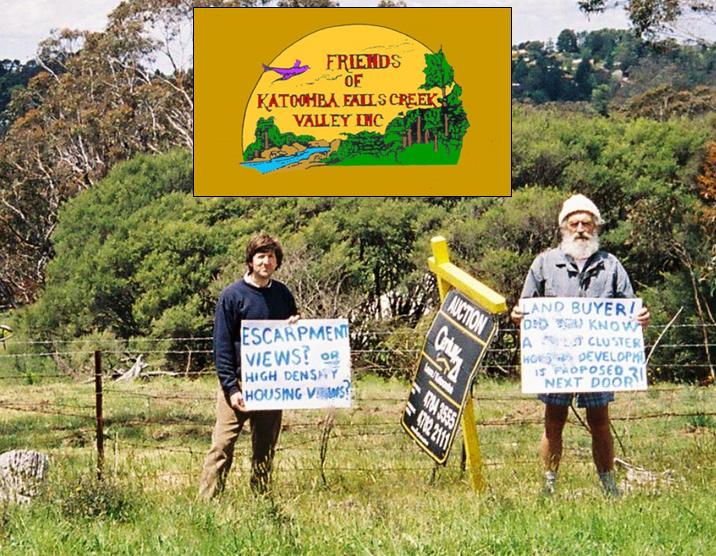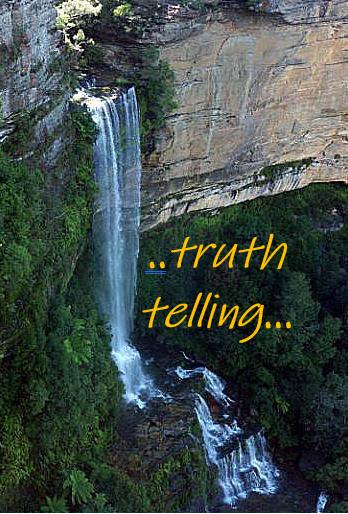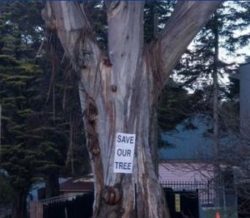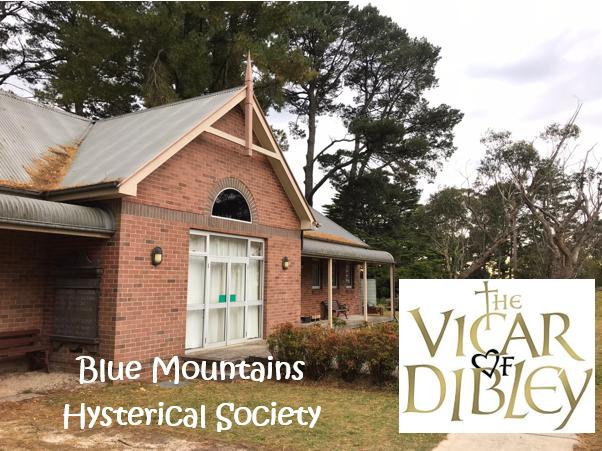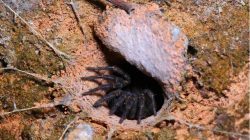Posts Tagged ‘Tony Burke’
Monday, May 20th, 2013
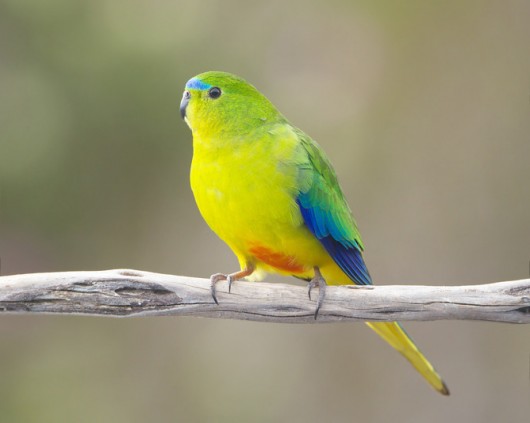 Orange-Bellied Parrot (Neophema chrysogaster)
Critically endangered and breeds only in Tasmania, Australia
[Source: Photo by John Harrison, in article ‘Threat of extinction demands fast and decisive action’, 20120724, by Tara Martin, published in The Conversation,
^http://theconversation.com/threat-of-extinction-demands-fast-and-decisive-action-7985] Orange-Bellied Parrot (Neophema chrysogaster)
Critically endangered and breeds only in Tasmania, Australia
[Source: Photo by John Harrison, in article ‘Threat of extinction demands fast and decisive action’, 20120724, by Tara Martin, published in The Conversation,
^http://theconversation.com/threat-of-extinction-demands-fast-and-decisive-action-7985]
.
Government Ecological Hypocrisy
.
While Australia’s governments at federal and state level continue to allow and encourage logging, burning and mining of Australia’s native forest ecosystems, many conservationists are well aware of that the loss of these forests habitats, and other human harmful actions are driving the extinction of Australia’s flora and fauna.
Threatened species can only be saved from extinction if first their habitat is properly protected from harm. Many species such as the Orange-Bellied Parrot which has now become critically endangered require more than just habitat protection, but active recovery intervention to save it from extinction. Yet this parrot species’ native habitats restricted to southern coastal Victoria and Tasmania are actively being destroyed as if government were sadistically and callously encouraging its extinction.
In governments we trust. Yet infamously in July 2009, the man who used to belt out “And the company takes what the company wants/And nothing’s as precious as a hole in the ground”, Midnight Oil’s Peter Garrett, as then entrusted Environment Minister, approved the Beverley Four Mile Uranium Mine in South Australia.
[Source: ‘Why Peter Garrett lost his way’, August, 2009, by David Glanz ^http://www.solidarity.net.au/best/why-peter-garrett-lost-his-way/]
.
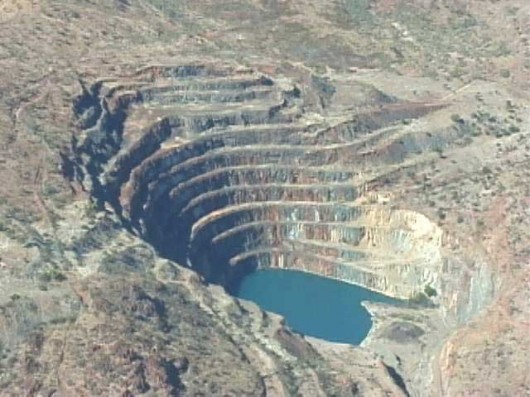 Beverley Four Mile Uranium Mine
550km north east of Adelaide Beverley Four Mile Uranium Mine
550km north east of Adelaide
.
At the most senior level, the Australian Government minister who is ultimately responsible and accountable to protect Australia’s natural ecology and to prevent flora and fauna extinctions, has his environment task diluted. Tony Burke MP is currently the Minister for (1) Sustainability (2) Environment (3) Water (4) Population (5) Communities (6) the Arts, which reflects the low value that the Australian Government places on protecting Australia’s Ecology.
 Australia’s recent Environment Ministers, respectively Peter Garrett and Tony Burke
Both Babyboomer Middle-Aged Men
Invariably in business, in politics, Babyboomer Middle-Aged Men
are the demographic drivers of ecological destruction across the planet. Australia’s recent Environment Ministers, respectively Peter Garrett and Tony Burke
Both Babyboomer Middle-Aged Men
Invariably in business, in politics, Babyboomer Middle-Aged Men
are the demographic drivers of ecological destruction across the planet.
.
Tony Burke has recently approved open coal mining that will destroy the Leard State Forest in New South Wales, remnant home of the increasingly rare Koala [^Read More].
Tony Burke has approved mining in Tasmania’s Tarkine (the last continuous wilderness region of Gondwana Rainforest home to more than 60 species of rare, threatened and endangered species including the Giant Freshwater Lobster, the Wedge Tailed Eagle, the Tasmanian Devil and the Orange-bellied Parrot [^Read More].
Tony Burke has recently approved logging to continue in recognised high conservation value native forests in Tasmania, previously agreed to be protected in an Intergovernmental Agreement between the federal and Tasmanian governments in Launceston on 7th August 2011 [^Read More].
Tony Burke has recently approved port development and shipping movements through the Great Barrier Reef for Rio Tintos’ bauxite mine in western Cape York, as well as a huge new coal export terminal at Abbot Point and at dredging of Gladstone Harbour despite the ongoing damage vital marine habitat supporting endangered species including turtles, dugongs and dolphins. [^Read More]
.
“For the powerful, crimes are those that others commit.”
~ Noam Chomsky, Imperial Ambitions: Conversations on the Post-9/11 World
.
 The 100 tonne coal ship the ‘Shen Neng 1’ which went aground on 5th April 2010, while negotiating the Great Barrier Reef
The ship destroyed 3km of the coral Douglas Shoal which it “completely flattened” and “pulverised” marine life. The marine park authority’s chief scientist, Dr David Wachenfeld, expressed concerned also about the toxic heavy metal anti-fouling paint scraping off the hull.
[Source: ‘Three kilometres of Great Barrier Reef damage, 20 years to mend’, 20100414, by Tom Arup, The Age newspaper,
^http://www.theage.com.au/environment/three-kilometres-of-great-barrier-reef-damage-20-years-to-mend-20100413-s7p8.html] The 100 tonne coal ship the ‘Shen Neng 1’ which went aground on 5th April 2010, while negotiating the Great Barrier Reef
The ship destroyed 3km of the coral Douglas Shoal which it “completely flattened” and “pulverised” marine life. The marine park authority’s chief scientist, Dr David Wachenfeld, expressed concerned also about the toxic heavy metal anti-fouling paint scraping off the hull.
[Source: ‘Three kilometres of Great Barrier Reef damage, 20 years to mend’, 20100414, by Tom Arup, The Age newspaper,
^http://www.theage.com.au/environment/three-kilometres-of-great-barrier-reef-damage-20-years-to-mend-20100413-s7p8.html]
.
Threatened Species Scientific Committee
– a toothless agency abused for ecopolitical spin
.
Then, at a lower level of government, a committee has been established since 2000 to advise Australia’s Environment Minister on issues associated with Australia’s increasing list of threatened species.
The Threatened Species Scientific Committee (TSSC) is legally established for under the Environment Protection and Biodiversity Conservation Act 1999 (EPBC Act), which superseded the 1992 Endangered Species Protection Act. The committee’s function is to advise the Minister for Sustainability, Environment, Water, Population and Communities (currentky Tony Burke MP) on:
- Amendments and updating of threatened species and threatened ecological communities lists
- Key Threatening Processes
- Preparing Species Recovery Plans and Threat Abatement Plans
- Scientific input into the Species Profile and Threats Database (^SPRAT)
- Advice on the presence of hybrids in listed ecological communities
- Hold periodic workshops dealing with issues concerning Australia’s threatened species and threatened ecosystems
.
Every year the committee publishes an annual report, except it has been six years since the Australian Government published one on its website. Here is the latest report from 2006-07. [>Read 2006-07 Report.pdf , 40kb) ]
.
[Source: ‘Threatened Species Scientific Committee’, ^http://www.environment.gov.au/biodiversity/threatened/committee.html]
.
Australia’s Threatened Fauna
.
As at the date of this article, the Australian Government lists the following statistics as our native fauna currently threatened with extinction to varying degrees, or now extinct.
Beware that government websites can change with whim and so the existence of the link below may disappear at any time.
.
Extinct:
- frogs (4)
- birds (23)
- mammals (27)
- other animals (1)
.
Extinct in the wild:
.
Critically Endangered:
- fishes (6)
- frogs (5)
- reptiles (4)
- birds (7)
- mammals (4)
- other animals (21)
.
Endangered:
- fishes (16)
- frogs (14)
- reptiles (16)
- birds (44)
- mammals (35)
- other animals (17)
.
Vulnerable:
- fishes (24)
- frogs (10)
- reptiles (36)
- birds (60)
- mammals (55)
- other animals (11)
.
Conservation dependent:
.
Total Threatened Fauna Species: (445)
.
[Source: Australia’s Threatened Flora, 2013, ^http://www.environment.gov.au/cgi-bin/sprat/public/publicthreatenedlist.pl]
.
Australia’s Critically Endangered Mammals
.
The above list is out of date, and the International Union for Conservation of Nature (IUCN) records are also out of date, because of the lack of diligent timely monitoring efforts by the Australian Government, and tardiness by the Australian Government in updating pertinent threatened species information back to the IUCN. Basically the Australian Government simply doesn’t care enough about Australian Ecology and dependent species about to become extinct.
It is a dire situation disgracefully detestable and sad.
According to an article in The Conversation back in December 2012, in respect to Australian mammal fauna, there are not four species deemed to be critically endangered to extinction, but now twelve, as listed below. Some of these may well be extinct such as the Christmas Island Pipistrelle..
The plight and demise of these species is not new. The Australian Government and its committees, reviews, reports and laws have confirmed this for many years. More committees, reviews, reports and laws equates to unforgiveable avoidance of moral and legal responsibility by the incumbent Environment Minister, this man:
.
 Tony Burke – the only grey haired Babyboomer in this photo
His demographic is responsible for the worst destruction of ecology across the Planet,
because the Nature-compromising values of males in this generation were formed when Nature was still considered plenty and its exploitation a God-given gospel.
Tony Burke’s values are wrong, inappropriate and his powerful decisions irreversible. Tony Burke – the only grey haired Babyboomer in this photo
His demographic is responsible for the worst destruction of ecology across the Planet,
because the Nature-compromising values of males in this generation were formed when Nature was still considered plenty and its exploitation a God-given gospel.
Tony Burke’s values are wrong, inappropriate and his powerful decisions irreversible.
.
- Woylie (Bettongia penicillata) also known as the Brush-tailed Bettong, or Brush-tailed Rat Kangaroo; a small marsupial found from south-west Western Australia across southern Australia.
- Mountain Pygmy Possum (Burramys parvus) – this tiny possum occurs as three isolated, genetically distinct populations in the alps of Victoria and NSW.
- Christmas Island Shrew (Crocidura trichura) – endemic to Christmas Island and hasn’t been seen since 1985. It is possibly extinct.
- Northern Hairy-nosed Wombat (Lasiorhinus krefftii) – approximately 200 of these wombats remain; they are limited to Epping Forest National Park (Scientific), and a reintroduced population at the Richard Underwood Nature Refuge, in Queensland.
- Lesser Stick-nest Rat (Leporillus apicalis) – this central-Australian rodent is probably extinct, with no reliable sightings since 1970.
- Bramble Cay (Melomys Melomys rubicola) – limited to a small cay in the Torres Strait, this rodent has one of the most restricted distributions of any mammal species.
- Lord Howe Long-eared Bat (Nyctophilus howensis) – known only from a single skull found in 1972, but Lord Howe Islanders continue to report bat sightings.
- Christmas Island Pipistrelle (Pipistrellus murrayi) – while listed as critically endangered, it’s generally accepted this little bat is now extinct.
- Gilbert’s Potoroo (Potorous gilbertii) – only 40 or so of these rabbit-sized marsupials live in south-west Western Australia, but the population seems stable.
- Kangaroo Island Dunnart (Sminthopsis aitkeni) – this little hand-sized marsupial is restricted to a very small area of Kangaroo Island.
- Carpentarian Rock Rat (Zyzomys palatalis) – a rodent found in sandstone gorges in the Northern Territory, there are thought to be less than 2000 remaining.
- Central Rock Rat (Zyzomys pedunculatus) – this rodent is found only in the western MacDonnell Ranges in the Northern Territory.
.
[Source: ‘Australia’s critically endangered animal species’, 20121206, by Jane Rawson, The Conversation, ^http://theconversation.com/australias-critically-endangered-animal-species-11169]
.
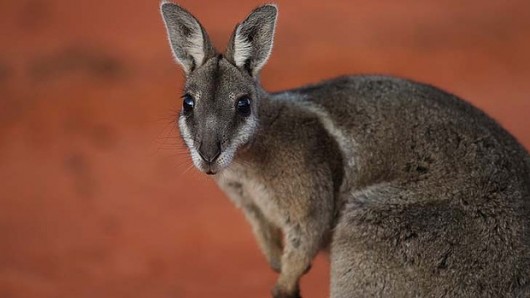 On the brink of extinction: the Bridled Nailtail Wallaby
[Source: Photo by Kate Geraghty, Dead and dying: our great mammal crisis’, 20121117, by Tim Flannery, The Age newspaper,
^http://www.theage.com.au/national/dead-and-dying-our-great-mammal-crisis-20121116-29hi9.html] On the brink of extinction: the Bridled Nailtail Wallaby
[Source: Photo by Kate Geraghty, Dead and dying: our great mammal crisis’, 20121117, by Tim Flannery, The Age newspaper,
^http://www.theage.com.au/national/dead-and-dying-our-great-mammal-crisis-20121116-29hi9.html]
.
Leadership, Accountability, Timely Action
.
According to Tara Martin, Research Scientist at Ecosystem Sciences at the CSIRO:
<<When it comes to mammal extinctions, Australia’s track record over the last 200 years has been abysmal. Since European settlement, nearly half of the world’s mammalian extinctions have occurred in Australia – 19 at last count. So, when faced with the additional threat of climate change, how do we turn this around and ensure the trend doesn’t continue?
Learning from previous extinctions is a good place to start. A comparison between two Australian species, the recently extinct Christmas Island pipistrelle and the critically endangered but surviving orange-bellied parrot, provides some insight into the answer to this question. Namely, that acting quickly and decisively in response to evidence of rapid population decline is a key factor in determining the fate of endangered species.
.
‘Government Delay condemn a species to extinction’
A Case of Government Delay:
.
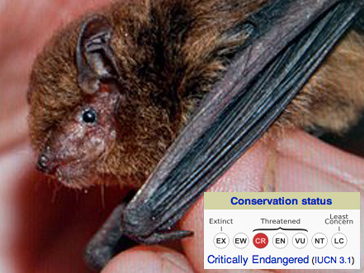 Species Extinction on Peter Garrett’s Watch
<< The Australian Government will invest $1.5 million to begin the rescue of Christmas Island’s ecosystem, including a mission to capture the last remaining Pipistrelle bats for captive breeding. “Volunteers and help from the Australasian Bat Society will be invaluable in this capture effort.” “My top priority now is to prevent any further extinctions and to restore the island’s environmental health,” Mr Garrett said.>>
A year later the critically endangered Christmas Island Pipistrelle (Pipistrellus murrayi) was declared extinct. Species Extinction on Peter Garrett’s Watch
<< The Australian Government will invest $1.5 million to begin the rescue of Christmas Island’s ecosystem, including a mission to capture the last remaining Pipistrelle bats for captive breeding. “Volunteers and help from the Australasian Bat Society will be invaluable in this capture effort.” “My top priority now is to prevent any further extinctions and to restore the island’s environmental health,” Mr Garrett said.>>
A year later the critically endangered Christmas Island Pipistrelle (Pipistrellus murrayi) was declared extinct.
[Source: ‘Christmas Island Pipistrelle Rescue’, 20090703, by Bat Conservation & Rescue Qld Inc., ^http://www.bats.org.au/?p=710]
.
<<Endemic to Christmas Island, the pipistrelle was a tiny (3.5 gram) insect-eating bat. It was first described in 1900, when numbers were widespread and abundant. In the early 1990s this began to change. The decline was rapid and the exact cause uncertain.
By 2006, experts were calling for a captive breeding program to be initiated. These pleas were ignored until 2009 when it was finally given the green light. Sadly the decision came too late, and two months (the then Minister for the Environment, Heritage and the Arts, Peter Garrett MP) announced that the rescue attempt had failed.>>
.
A Case of Government Action (so far):
.
<<Concern about the orange-bellied parrot began in 1917, but it wasn’t until 1981 that it was confirmed to be on the brink of extinction. In an attempt to save the parrot, a multi-agency, multi-government recovery team was set up and a captive breeding program began in 1983.
Like the bat, threats to the parrot remain poorly understood. In 2010, monitoring showed that the species would become extinct in the wild within three to five years unless drastic action was taken. The recovery team immediately took action to bolster the captive population as insurance against extinction. There are currently 178 birds in captivity and less than 20 in the wild.
.
<<…How we manage endangered species ultimately comes back to the decisions made, including who makes the decisions, who is held accountable, and the timing of these decisions.
Examining these cases in the context of decision-making reveals some clear differences and highlights some important recommendations for the future management of endangered species.
One of the key differences was in the governance and leadership surrounding the two cases. Experts involved in monitoring the pipistrelle provided recommendations to government bodies, but did not have the authority to make decisions nor was there an effective leader to champion the urgent need to act. Conversely, the Orange-bellied Parrot Recovery Team had the authority to make decisions and act on them. Indeed, thanks to the Recovery Team’s broad representation, any failure to act would likely have resulted in public outcry – which raises the issue of accountability.
Management of endangered species requires tough decisions, yet they are decisions we must make. If we monitor declining populations without a process for deciding between different management options, we will only document extinctions. In some cases, the logical decision may be to employ a triage system where priority is given to species with a high likelihood of recovery. Assigning institutional accountability around the management of endangered species could help to ensure that tough decisions are made and that the processes involved are transparent.
Finally, the cases of the bat and the parrot also highlight the need to act quickly when a species is found to be on the brink of extinction. Delaying decisions only narrows our choices and removes opportunities to act. We may not always have all the answers, but this cannot be used as a reason to delay decision making. Based on a triage system a decision to not to act might be the best way forward, but if we delay the decision it becomes the only way forward.
..scientific analysis can be used to determine how much information we need to inform a good conservation decision. In the case of the Christmas Island pipistrelle, the decision to start a captive breeding program came many years too late.
By evaluating the costs, benefits, and feasibility of taking different management actions in the light of what we know about a species’ decline (or don’t know – i.e. the degree of uncertainty), it is possible to get the timing right.
Research into the methods used to stem species decline is also underway. For example, captive breeding and reintroduction programs are generally regarded as having good success rates. Further investigation into genetic management, habitat restoration, and effective techniques for reintroduction and risk management will help ensure the success of these programs for a variety of species.
Stemming the global loss of biodiversity through Species Recovery Planning will require brave decision-making in the face of uncertainty. Monitoring must be linked to decisions, institutions must be accountable for these decisions and decisions to act must be made before critical opportunities, and species, are lost forever.>>
.
[Source: ‘Threat of extinction demands fast and decisive action’, 20120724, by Tara Martin, Research Scientist, Ecosystem Sciences at CSIRO, (based on a paper by Tara Martin and with input from co-authors Mark Holdsworth, Stephen Harris, Fiona Henderson, Mark Lonsdale, in The Conversation, ^http://theconversation.com/threat-of-extinction-demands-fast-and-decisive-action-7985]
.
.
Principles to Properly Protect Threatened Species
.
The Australian Government is accountable for the conservation of Australia’s natutral environment and dependent species, particularly those at risk of extinction. It is charged with the democratic authority to do so and the Australian people entrust it to act responsibly. The Australian Government since 1999 had in place a national law protecting threatened species under its Environment Protection and Biodiversity Conservation Act, and since 2000 had an expert Threatened Species Scientific Committee advising it on priorities for threatened species and key threatening processes and recommended conservation actions.
But having a framework for conservation action is two steps short of the conservation action itself. Without proper funding and timely onground action, government environmental conservation is but hypocritcal lip service.
.
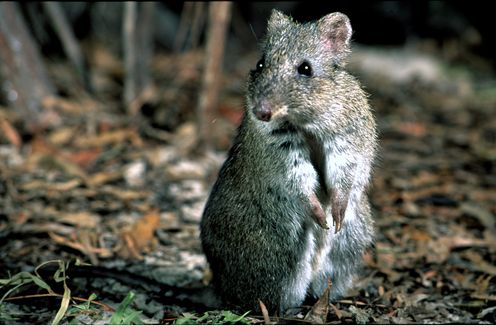 Gilbert’s Potoroo – only 40 left Gilbert’s Potoroo – only 40 left
.
2008 Review of Threatened Species Protection
.
Section 522A of the EPBC Act requires it to be reviewed every 10 years from its commencement. So on 31 October 2008, Peter Garrett MP as the then Minister for the Environment, Heritage and the Arts, commissioned an independent review of the Environment Protection and Biodiversity Conservation Act 1999 (EPBC Act), the Australian Government’s central piece of environmental legislation.
The Terms of Reference were:
- the operation of the EPBC Act generally
- the extent to which the objects of the EPBC Act have been achieved
- the appropriateness of current matters of National Environmental Significance
- the effectiveness of the biodiversity and wildlife conservation arrangements
- Seek input from state and territory governments, members of the community and industry
.
The review to be guided by key Australian Government policy objectives:
- To promote the sustainability of Australia’s economic development to enhance individual and community well-being while protecting biological diversity and maintaining essential ecological processes and systems
- To work in partnership with the states and territories within an effective federal arrangement
- To facilitate delivery of Australia’s international obligations
- The Australian Government’s deregulation agenda to reduce and simplify the regulatory burden on people, businesses and organisations, while maintaining appropriate and efficient environmental standards
- To ensure activities under the Act represent the most appropriate, efficient and effective ways of achieving the Government’s outcomes and objectives in accordance with the Expenditure Review Principles.
.
The review was undertaken by Dr Allan Hawke (government representative) supported by a panel of experts- a retired NSW judge Paul Stein AM, Professor Mark Burgman (Environmental Science), Professor Tim Bonyhady (Environmental Law), Rosemary Warnock (ethical standards and the environment).
Community participation in the review was encouraged and 220 written submissions were received and 140 face-to-face consultation meetings were held in capital cities around Australia. An Interim Report on the review was released and a further 119 written comments were received. The Final Report was delivered to the Minister on 30 October 2009 and publicly released on 21 December 2009.
On 24 August 2011, the Minister released the Australian Government response to the independent review, three years after the review process began and about a year after the ten year review deadline.
The response centred around four key themes:
- Abandonning targeted actions to save critically endangered threatened species, and instead to vague “strategic approaches” and more plans
- Simplification of the assessment and approval processes for threatened species – vague, cheaper and less research work
- Big picture ecosystem approach
- Compromise of national standards to “harmonise” conservation approaches with the States having different priorities
.
Irrespective of the 220 written submissions and 140 face-to-face consultation meetings, out of the 71 recommendations in the Final Report, the Australian Government agreed either in part, in principle, in substance, but has since done precious little to protect Australia’s threatened species.
The review process was stipluated in the EPBC Act, but all it achieved was an opportunity for the Australian Government to undermine the 1999 standards, water down national environmental protection legislation, simplify the government’s administration and save money. Effectively the EPBC Review was a bureacratic talk fest and an expensive waste of time and taxpayer money that would have been better spent on implementing known critically endengerd species and their habitats.
The survival of Australia’s threatened species remain at the whim of federal and state governments.
What did the entire review process cost including the consultants? The amount is secret. Was it $10 million, more? The estimated cost of a Species Recovery Plans and Threat Abatement Plan to save the critically endangered Orange-bellied Parrot is how much?
Meanwhile, as few as 250 Orange-bellied Parrots remain in existence, making the species one of the most endangered species on the planet.
Meanwhile, community volunteers with The Friends of the Orange-Bellied Parrot and Wildcare Inc. in Tasmania continue to monitor the Orange-bellied Parrots during their breeding season in far southwest Tasmania’s Wilderness World Heritage Area. Members live for periods of 10 days at Birch Inlet and Melaleuca in Tasmania’s Wilderness World Heritage Area, making observations of the daily lives of the OBPs, including birds that have been bred in captivity and released at the beginning of the season as part of the Species Recovery Plan for the Orange-Bellied Parrot.
They don’t get money from the Australian Government and so have set up the Save the Orange-bellied parrot Fund. Wildcare Inc volunteers receive a small reimbursement allowance from the Tasmanian Government’s watered down Department of (1) Primary Industries, (2) Parks, (3) Water and oh yeah (4) Environment to assist with their costs.
.
[Source: Wildcare Incorporated, Tasmania, ^http://www.wildcaretas.org.au/]
.
.
.
.
.
[Source: Australian Government, ^http://www.environment.gov.au/epbc/review/]
.
2012 Review of Threatened Species Protection
.
After the entire the EPBC Act Review process and a year after the Australian Government’s response to it, on 31 October 2012 the Australian Senate this time set up yet another review into the Effectiveness of Threatened Species and Ecological Communities’ Protection in Australia. It commissioned a Senate Standing Committee on Environment and Communications for enquiry and report.
This second review process came in light of the rubber stamp realisation by The Greens Senator Larissa Waters of how the Australian Government had poorly treated the EPBC Review and in light of the Auditor General report that Victoria’s environment and primary industry departments are failing to act as proper watchdogs [^Read More]. Further to that we’ve seen Professor Tim Flannery publish his opinion piece (from the Monthly’s Quarterly Essay) on the extinction crisis pointing some of the blame at the Commonwealth’s inaction [^Read More].
Public submissions were to be received by 14th December 2012 and the reporting date scheduled to be 7th February 2013, but rather late again on 14th May 2013, the Senate granted an extension of time for reporting until 20 June 2013 (one month’s time from the date of this article).
The Terms of Reference are:
(a) Management of key threats to listed species and ecological communities
(b) Development and implementation of Species Recovery Plans
[Ed: About time, and what about commensurate Threat Abatement Plans? One is ineffective without the other.]
(c) Management of critical habitat across all land tenures
(d) Regulatory and funding arrangements at all levels of government
(e) Timeliness and risk management within the listings processes
(f) The historical record of state and territory governments on these matters
(g) Any other related matter.
.
[Sources: ‘The effectiveness of threatened species and ecological communities’ protection in Australia’, Terms of Reference, Australian Senate,^http://www.aph.gov.au/Parliamentary_Business/Committees/Senate_Committees?url=ec_ctte/threatened_species/tor.htm; ‘Threatened species in the senate spotlight’, 20121121, Councillor Samantha Dunn, Shire of Yarra Ranges, Victoria, Australia (website), ^http://crdunn.blogspot.com.au/2012/11/threatened-species-in-senate-spotlight.html]
.
Public submissions received by the Senate Committee
.
1 Mr Gabriel Lafitte (PDF 39KB)
2 Dr Todd Soderquist and Dr Deborah Ashworth (PDF 41KB) Attachment 1(PDF 395KB)
3 Mr Marcus Coghlan (PDF 91KB)
4 Australasian Native Orchid Society and the Australian Orchid Council (PDF 309KB)
5 Ms Fay Jones (PDF 4KB)
6 Monaro Acclimatisation Society Inc (PDF 267KB)
7 Mr James Samargis (PDF 56KB)
8 Mr Stephen Chara (PDF 432KB), Supplementary Submission(PDF 1213KB)
9 Mr Sab Lord, Lords Kakadu and Arnhemland Safaris (PDF 9KB)
10 Ms Kylie Jones (PDF 43KB)
11 East Gippsland Wildfire Taskforce Inc (PDF 1483KB)
12 Regent Honeyeater Project (PDF 9KB) Attachment 1(PDF 2946KB)
13 Mr Rob Brewster (PDF 2063KB)
14 Mr Tom Kingston (PDF 16KB)
15 Professor David Lindenmayer (PDF 44KB)
16 Mr Frank Manthey OAM, Save the Bilby Fund (PDF 189KB), Supplementary Submission(PDF 1154KB)
17 Friends of Tootgarook Wetland Reserves (PDF 390KB)
18 Mr Jim Walker (PDF 193KB)
19 Ms Harriett Swift (PDF 34KB), Supplementary Submission(PDF 11KB)
20 Island Conservation (PDF 1011KB)
21 Wildflower Society of Western Australia (Inc) (PDF 161KB)
22 Mr Daniel Bell (PDF 11KB)
23 Marie-Louise Sarjeant, Chris Sarjeant, Sonia Hutchinson, John Marsh, Maxine Jacobsen, Diana Kellett, Lesley Palma (PDF 945KB)
24 Save Tootgarook Swamp Inc (PDF 1777KB)
25 Ms Joan Spittle (PDF 83KB)
26 Mr John Jeayes (PDF 431KB)
27 Zoo and Aquarium Association (PDF 57KB)
28 Ray and Marion Lewis (PDF 239KB)
29 Mr Jean Dind (PDF 32KB)
30 Associate Professor Adrian Manning (PDF 97KB) Attachment 1(PDF 370KB), Supplementary Submission(PDF 167KB)
31 Port Campbell Community Group Inc (PDF 152KB)
32 Mr Philip Collier (PDF 790KB)
33 Mr Trevor Parton (PDF 58KB)
34 Mr Ian Wheatland, Mr Kai May, Dr Katherine Phillips and Mrs Nina Kriegisch (PDF 126KB)
35 Ms Susan M Broman (PDF 890KB)
36 Sister Marian McClelland sss (PDF 29KB)
37 Finch Society of Australia Inc (PDF 65KB)
38 Clarence Valley Conservation Coalition (PDF 250KB)
39 Ms Mary White rsm (PDF 273KB)
40 Ms Marie Hilarina Fernando (PDF 103KB)
41 Dr Emma Rooksby and Dr Keith Horton (PDF 63KB)
42 Zoos Victoria (PDF 240KB)
43 The Colong Foundation for Wilderness (PDF 376KB)
44 Mr Stewart Kerr (PDF 5KB)
45 Mr Peter Berbee (PDF 24KB)
46 Dr Andrew Burbidge (PDF 69KB)
47 Name Withheld (PDF 45KB)
48 Professor John Woinarski (PDF 157KB)
49 Ms Lee Curtis (PDF 100KB)
50 Mr Thomas Weiss (PDF 36KB)
51 Dr Peter Kyne (PDF 387KB)
52 Dr Greg P Clancy (PDF 218KB)
53 Mr Trent Patten (PDF 1536KB)
54 Ms Sabine Ritz-Kerr (PDF 47KB)
55 Dr Martine Maron (PDF 196KB)
56 Ms Claire Masters (PDF 39KB)
57 The Wentworth Group of Concerned Scientists (PDF 2022KB)
58 Mr Jonathan Meddings (PDF 817KB)
59 Mr Nigel Sharp (PDF 329KB)
60 Assoc Prof Mark Lintermans (PDF 54KB)
61 Ms Pamela J W Miskin (PDF 66KB)
62 South East Forest Rescue (PDF 646KB)
63 Clarence Environment Centre (PDF 137KB)
64 Mr Craig Thomson (PDF 116KB)
65 Ms Peta Whitford (PDF 222KB)
66 Mr Daryl Dickson, Wildcard Art, Mungarru Lodge Sanctuary (PDF 269KB)
67 Ms Sera Blair (PDF 349KB)
68 Ms Kerryn Blackshaw (PDF 5KB)
69 Yarra Ranges Council (PDF 107KB)
70 Lawyers for Forests (PDF 1159KB)
71 Name Withheld (PDF 23KB)
72 Mr Greg Miles (PDF 157KB) Attachment 1(PDF 600KB) Attachment 2(PDF 4770KB)
73 Bendigo and District Environment Council, Bendigo Field Naturalists Club and Bendigo Sustainability Group (PDF 364KB) Attachment 1(PDF 173KB) Attachment 2(PDF 1923KB)
74 Dr Jasmyn Lynch (PDF 80KB)
75 Blue Mountains Conservation Society (PDF 202KB)
76 Wildlife Preservation Society of Queensland (PDF 246KB)
77 CSIRO (PDF 284KB)
78 Dr Chris McGrath (PDF 245KB)
79 Mr David Blair (PDF 195KB)
80 Name Withheld (PDF 183KB)
81 WWF-Australia (PDF 553KB) Attachment 1(PDF 378KB) Attachment 2(PDF 204KB)
82 BirdLife Australia (PDF 715KB) Attachment 1(PDF 1129KB)
83 Australian Deer Association (PDF 732KB)
84 LIV Young Lawyers’ Section, Law Institute of Victoria (PDF 1209KB) Attachment 1(PDF 4436KB) Attachment 2(PDF 1303KB), Supplementary Submission(PDF 335KB)
85 Stanislaw Pelczynski and Barbara Pelczynska (PDF 245KB)
86 Friends of Grasslands (PDF 100KB)
87 Dr Kerryn Parry-Jones (PDF 239KB) Attachment 1(PDF 2143KB)
88 Humane Society International (PDF 550KB)
89 Mr Jeremy Tager (PDF 1441KB), Supplementary Submission(PDF 185KB)
90 Ms Karena Goldfinch (PDF 141KB)
91 Mr Ray Strong (PDF 95KB)
92 Healesville Environment Watch Inc, MyEnvironment Inc and Friends of Leadbeater’s Possum Inc (PDF 2435KB)
93 Mr Ian Whitford (PDF 226KB)
94 Greenfleet (PDF 105KB)
95 Mr Barry Rowe, Candlebark Community Nursery Inc (PDF 178KB)
96 Conondale Range Committee (PDF 156KB)
97 Dr John Clulow (PDF 61KB)
98 Ms Melinda Taylor (PDF 73KB)
99 Mr David Hudson (PDF 78KB)
100 Ms Yasmin Kelsall (PDF 340KB)
101 S. Burgess and E. Bradley (PDF 61KB)
102 Ms Glenda Pickersgill (PDF 86KB)
103 Dr Tanzi Smith (PDF 249KB)
104 The Greater Mary Association Inc. (PDF 234KB)
105 Mr Philip Rance (PDF 651KB)
106 Caldera Environment Centre (PDF 416KB)
107 Mr Bruce Boyes (PDF 1505KB)
108 Australian Wildlife Health Network (PDF 418KB)
109 Friends of Hoddles Creek (PDF 1403KB)
110 Australasian Bat Society Inc (PDF 413KB)
111 Confidential
112 Confidential
113 Canberra Ornithologists Group (PDF 229KB)
114 Urban Bushland Council WA Inc (PDF 112KB)
115 MRCCC (PDF 559KB)
116 Threatened Ecosystems Network (PDF 1606KB)
117 Wildlife Disease Association Australasia (PDF 71KB)
118 Name Withheld (PDF 237KB)
119 Mr Andrew Heaver (PDF 126KB)
120 Name Withheld (PDF 76KB)
121 Ms Kate Leahy (PDF 35KB)
122 Dr Jonathan Rhodes (PDF 68KB)
123 Professor Lee Godden and Professor Jacqueline Peel (PDF 136KB) Attachment 1(PDF 123KB) Attachment 2(PDF 327KB)
124 Earth Learning Incorporated (PDF 352KB)
125 NSW Council of Freshwater Anglers (PDF 671KB)
126 Mr Mark Selmes (PDF 141KB)
127 Professor Hugh Possingham and Associate Professor Michael McCarthy (PDF 102KB)
128 Ms Susan Bendel (PDF 99KB)
129 The Wilderness Society Inc (PDF 68KB)
130 Minister for Environment and Heritage Protection Queensland (PDF 3463KB)
131 Ms Lorraine Leach (PDF 293KB)
132 Dr John Bardsley (PDF 1070KB)
133 Mr Wayne Gumley (PDF 144KB)
134 Nature Conservation Council of NSW (PDF 783KB)
135 Middle Kinglake Primary School (PDF 2301KB)
136 The Judith Eardley Save Wildlife Centre (PDF 1595KB)
137 Australian Network of Environmental Defender’s Offices Inc (PDF 214KB) Attachment 1(PDF 1129KB)
138 Ms Jenifer Johnson (PDF 1917KB)
139 Batwatch Australia (PDF 270KB)
140 Invasive Species Council (PDF 421KB)
141 Dr Rupert Baker (PDF 50KB)
142 National Parks Australia Council (PDF 331KB) Attachment 1(PDF 734KB) Attachment 2(PDF 3164KB)
143 Department of Sustainability Environment Water Population and Communities (PDF 1098KB)
144 Director of National Parks (PDF 249KB)
145 National Parks Association of NSW (PDF 196KB)
146 Mr Don Butcher (PDF 694KB)
147 Australian Conservation Foundation (PDF 725KB) Attachment 1(PDF 1129KB)
148 Australian Fisheries Management Authority (PDF 638KB)
149 Environment East Gippsland Inc. (PDF 2834KB)
150 Nature Conservation Society of South Australia (PDF 196KB)
151 Arid Lands Environment Centre (PDF 182KB)
152 Ms Prue Acton (PDF 394KB)
153 Ms Bronwyn Baade (PDF 55KB)
154 Threatened Species Scientific Committee (PDF 255KB)
155 VETO (VETO Energex Towers Organisation) (PDF 1695KB) Attachment 1(PDF 199KB)
156 Gecko – Gold Coast and Hinterland Environment Council and Save Bahrs Scrub Alliance (PDF 508KB) Attachment 1(PDF 569KB)
157 Threatened Plant Action Group (TPAG), Nature Conservation Society of South Australia (PDF 332KB)
158 FrogWatch (PDF 121KB)
159 Department of Land Resource Management, Northern Territory Government (PDF 8000KB)
160 Wildlife Preservation Society of Queensland, Gold Coast and Hinterland Branch (PDF 202KB)
161 North Coast Environment Council (PDF 594KB) Attachment 1(PDF 3788KB) Attachment 2(PDF 1914KB)
162 Australian Wildlife Conservancy (PDF 400KB) Attachment 1(PDF 637KB) Attachment 2(PDF 433KB)
163 MyEnvironment Inc (PDF 6137KB)
164 South East Region Conservation Alliance Inc (PDF 3514KB)
165 Logan and Albert Conservation Association (PDF 306KB) Attachment 1(PDF 197KB) Attachment 2(PDF 147KB)
166 PGV Environmental (PDF 916KB)
167 National Farmers’ Federation (PDF 61KB)
168 Wide Bay Burnett Enviroment Council (PDF 1311KB)
169 Premier of Western Australia (PDF 14211KB)
170 Confidential
171 Confidential
172 The Wilderness Society Victoria Inc (PDF 1182KB), Response from VicForests, dated 29 January 2013(PDF 78KB)
173 Brisbane Region Environment Council (PDF 965KB)
174 North East Forest Alliance (PDF 2272KB), Response from Forestry Corporation, NSW(PDF 2036KB)
175 Eagle Junction State School (PDF 12260KB)
176 Hunter Bird Observers Club (PDF 387KB)
177 Ms Margaret Peachey (PDF 63KB)
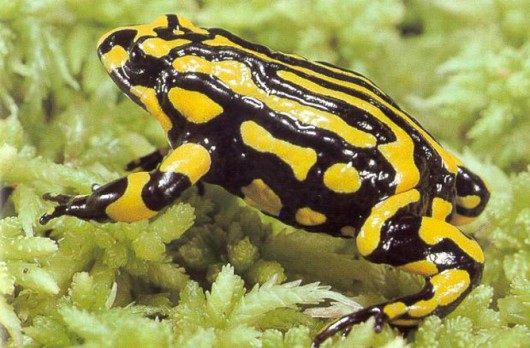 Southern Corroborree Frog (Pseudophryne corroboree)
Endemic to yet critically endangered in the Australian Alps. Southern Corroborree Frog (Pseudophryne corroboree)
Endemic to yet critically endangered in the Australian Alps.
Its demise has been directly caused by habitat destruction from recreational 4WD use, development of ski resorts,
introduced feral animals and human degradation of the frogs’ habitat.
As of June 2004 it was estimated to have a population of just 64.
.
Submission #82 by BirdLife Australia
.
Australia’s leading independent conservation advocate for native birds and their habitats, BirdLife Australia, has its own Threatened Species Committee. In its submission to the review, BirdLife Australia called on Australia’s national environment law, the EPBC Act, to:
.
-
Be accountable
-
Be transparent
-
Deliver on our international commitments
-
Specify measurable ecological outcomes
-
Have a mandate to intervene on matters that are national in scope
-
Be resourced and enforced
-
Give the Australian Community a voice on national environmental matters
-
Be based on independent advice
.
Specifically these were its recommendations in detail:
.
Be accountable
.
a. The Act should require that national environmental accounts are developed (Recommendation 67), produced annually, and include Matters of National Environmental Significance (MNES). Within this the IUCN Red List Index could be used to provide a measure of performance in the threatened species protection and management.
b. The Act should establish an Independent Environment Commission to provide objective, science-based advice to the Minister to improve decision-making and ensure greater transparency and accountability (Recommendation 71). The Commission should be responsible for independent monitoring, audit, compliance and enforcement activities under the Act.
c. The Act should prescribe mandatory decision-making criteria for ecological outcomes (Recommendation 43). All actions should be legally required to maintain or improve ecological outcomes, or to demonstrate a net improvement in national environmental accounts (for each relevant MNES).
d. Regional Forest Agreements require an independent review and a more rigorous approach to auditing. A process for public input and sanctions for serious non-compliance are required. The full protections of the Act should apply to forest activities where the terms of the RFAs are not being met (Recommendation 38).
.
Be transparent
.
a. Transparency in decision-making must be maintained and improved. Current proposals do not go far enough, for example statements of reasons for all decisions made by the Minister and delegates under the Act should be released at time of the decision (Recommendation 44(1)(c)).
b. The Act must provide greater access to the courts for public interest litigation. The Government’s Rejection of Recommendations 48-53 is a key failure of the Government’s response to provide suitable checks and balances for proposals to “streamline” processes.
c. A core element of Hawke’s reform package was to provide for environmental performance audits and inquiries. The Australian Government should be subject to regular environmental performance audit under a new specialist Environmental Performance Audit Unit in the Australian National Audit Office, provided for under the Auditor-General Act 1997.
.
Deliver on our international commitments
.
a. Critical habitat must be protected, with impacts on critical habitat equated to impact on species, and consideration given to the critical habitat required under climate change (Recommendation 12 (1)). However we feel that the critical habitat register should be retained and its remit expanded.
b. The Environment Minister requires powers to develop and implement management plans to protect the values of World Heritage properties, National Heritage Places and Ramsar wetlands where the collaborative processes have not produced effective plans (Recommendation 34).
.
Specify measurable ecological outcomes
.
a. The Act should specify required ecological outcomes. This could be delivered through specified reporting periods for MNES, such as on Species Recovery Plans and Threat Abatement Plans to ensure accountability. The Government agreed the Act should include provisions that enable the auditing of environmental outcomes (performance audits) (Recommendation 61).
.
Have a mandate to intervene on matters that are national in scope
.
a. The primary object of the Act should be ‘to protect the environment’ (Recommendation 3).
b. The Act, and the way it is administered, needs to better reflect the principles of Ecological Sustainable Development (Recommendation 2).
c. The process proposed in the Government response for listing ecosystems of national significance under the Act is too restrictive and inflexible.
d. The National Reserve System should be included as a MNES.
.
Be resourced and enforced
.
a. Cost recovery mechanisms under the Act are needed to ensure that the Environment Department is adequately resourced to ensure operation of the Act and monitor performance (Recommendation 62).
b. A Reparation fund should be established (Recommendation 60). Give the Australian Community a voice on national environmental matters
a. We strongly support the creation of a call in power for ‘plans, policies and programs’ that may have a significant impact on a MNES to better deal with cumulative impacts.
.
Be based on independent advice
a. The quality of Environmental Impact Assessment (EIA) information needs to be substantially improved. An industry Code of Conduct for consultants supplying information for EIA and approval under the Act should be developed and the Minister, or the Environment Commission, should audit assessment information (including protected matters) to test assertions made in EIAs (Recommendation 24).
b. The Environment Commission should also be tasked with establishing a process to free consultants from their commercial dependency on proponents.
.
[Source: ‘Submission to the Australian Senate Standing Committees on Environment and Communications entitled ‘The effectiveness of threatened species and ecological communities’ protection in Australia’, 20130308, by Professor Stephen Garnett(Coordinator – BirdLife Australia’s Threatened Species Committee) and Samantha Vine (Head of Conservation – BirdLife Australia, ^http://birdlife.org.au/].
.
 Margaret River burrowing crayfish (Engaewa pseudoreducta)
[© Photo by Quinton Burham]
With only two known populations, the Margaret River burrowing crayfish is highly endangered.
Even one of these may no longer exist, as there have been no sightings since 1985.
The threats are almost all attributed to human activity.
Land clearing is the biggest danger, as crayfish habitat can be eroded or contaminated by farming, mining and urban development.
Feral pigs also damage habitat.
[Source: ^http://www.australiangeographic.com.au/journal/australias-most-endangered-species.htm] Margaret River burrowing crayfish (Engaewa pseudoreducta)
[© Photo by Quinton Burham]
With only two known populations, the Margaret River burrowing crayfish is highly endangered.
Even one of these may no longer exist, as there have been no sightings since 1985.
The threats are almost all attributed to human activity.
Land clearing is the biggest danger, as crayfish habitat can be eroded or contaminated by farming, mining and urban development.
Feral pigs also damage habitat.
[Source: ^http://www.australiangeographic.com.au/journal/australias-most-endangered-species.htm]
.
Submission #85 by our regular contributors
.
<<We acknowledge the Indigenous Nations of Australia as the traditional owners of its land and waters. We thank them for the ecological wisdom they did and continue to pass to us.
We have read and agree with the contents of the two submissions to the Committee from Marie-Louise Sarjeant, Chris Sarjeant, Sonia Hutchinson, John Marsh and Maxine Jacobson, and from Wendy Radford for BDEC, Stuart Fraser for BFNC and Sara Hill and wish to take this opportunity to register with the Committee our endorsement of them.
.
Introduction
.
<<When about 50 years ago we became involved in environmental issues, we never thought that we will be witnessing in our lifetime the degree of environmental degradation we are witnessing now.
The rate at which the degradation is now occurring is very alarming, as given that global warming and loss of biodiversity exacerbate each other, there is a real possibility that unless we act now, this positive feedback cycle will escalate beyond our ability to prevent it from resulting in the collapse of our life supporting natural ecosystems.
Over the last 20 years that we lived on a property in the forest near Bendigo we personally witnessed the progressive local extinction of the swamp wallaby due to road kills, loss of habitat to development, degradation of the Greater National Park due to fuel reduction burns and weed infestation, including invasive plants escaping from ornamental gardens, replacement of native trees in Bendigo’s streetscapes with exotics and escalation of a thriving population of Indian mynas – and all this, in spite of the biodiversity strategies, environmental protection legislations and scores of submissions, Panel and VCAT hearings.
Why is it then that we are failing to provide effective protection to our biodiversity?
In this submission we will list some of the reasons for this failure.
.
Evidence of the ineffectiveness of threatened species and ecological communities’ protection in Australia
.
The ineffectiveness of threatened species and ecological communities’ protection is evident from the Natural Heritage Trust’s “Australian Terrestrial Biodiversity Assessment 2002” report and from the successive “State of the Environment” reports which show that all the important environmental indicators are getting worse.
The reasons for this ineffectiveness is:
.
Promotion of populations growth
.
Concerns about the unsustainability of population growth and its impact on the natural environment is very well documented (Bartlett 1998, Catton 1982, Lowe 2005, p 59, Suzuki2010, pp 20 and 21) and yet population growth continues to be supported and promoted by politicians (Creighton 2012) and business, while the wide spread misconceptions about it still persist without effective challenge (Lowe 2012).
.
We submit that the Committee recommends that an ecological limit to population growth is determined and implemented into our policy and decision processes
.
Failure to recognize the role apex, or top-order, predators play in the conservation of Australia’s biodiversity
.
The failure by Euro-Australians to recognize the apex terrestrial predators function in sustaining a balance of species that is viable in the long term and in keeping the numbers down of introduced feral species, has and continues to contribute to the decline of Australia’s biodiversity and adversely affects the effectiveness of threatened species and ecological communities protection.
In the case of the avian apex predator, the Wedge-tail Eagle (Aquila audax), the recognition and acceptance of its value to the environment and to farmers took number of years after CSRIO published its research results in the second half of last century.
Unfortunately, in the case of the mammalian apex predator, the dingo (Canis lupus dingo), until recent years “dingoes have rarely been studied to reach a larger understanding of our place in the Australian environment. Dingoes have mainly been studied so humans can maximize the efficacy of control efforts, capitalize on available resources and increase short-term economic gain” (Purcell 2010, p. 117), with the obvious consequent enforcement of people’s misconceptions and detrimental treatment of the dingo.
The adverse effects of the current management under the Fraser Island Dingo Management Strategy as detailed in Marie-Louise Sarjeant et al Submission of 23-11-12 to this Committee and of the mainland controls, especially by aerial baiting (Bullen 2012, Purcell 2010, p. p 3, 116, 137) on the dingo population and its culture as well as on livestock, show the urgency with which the current research (De Bias 2009, Johnson et al 2007, Purcell 2010, Wallach and O’Neill 2008, Brook et al 2012, Wallach and Johnson) needs to be taken seriously, supported by funding and implemented.
We stress here that unlike domestic dogs, cats and foxes that breed twice a year, dingoes breed only once a year, like wolfs do, are self- regulating (Purcell 2010, pp 10 and 113) and do not breed during droughts (Purcell 2010, p 24); they form small packs with hierarchical structure with only the alpha pair reproducing. The alpha pair teaches its offsprings about the packs territory and what and how to hunt, especially how to hunt kangaroos. These characteristics and not its coat colour, skull shape or genetic “purity” makes the dingo so important to Australia’s ecology (Purcell 2010, pp 39, 40, 101). Our disturbing its pack structure and culture is what causes the problem (Purcell 2010, pp3, 116,137). After all, the dingoes coexisted with Aboriginal people for thousands of years without being a problem to humans or ecology. Because their diet consists mainly of kangaroos and rabbits and not as popularly believed livestock (Purcell 2010, p 50), dingoes, like wedge-tailed eagles, are also beneficial to farmers.
We therefore submit that the Committee recommends that in order to improve the effectiveness of threatened species protection, management of key threats to listed species and of Species Recovery Rlans, the dingo needs to be reclassified as protected. New research should be funded and its findings implemented into management and a Species Recovery Plan.
We also submit that, given the Indigenous Peoples’ knowledge of the dingo, its role as the apex predator, the interdependence of species and the importance of maintaining balance (Parker 2007, Rose 1987, Rose 2000, Rose 2011), the Committee recommends that the object 3(2)(9)(iii) of the EPBCA 1999 be taken seriously and Indigenous Peoples’ role in and knowledge of the dingo and its part in the conservation of biodiversity be implemented into the management of the conservation of species and ecological communities.
.
Failure to address our cultural maladaptations, especially our culture of exuberance
.
“The culture of exuberance seemed to impute almost supernatural capabilities to Homo sapiens. It prevented us from seeing that the process of “creating our own habitat” might be a trap, the technology might come to enlarge our resource appetites instead of our world’s carrying capacity” (Catton 1982, p 122).
In the new branch of the study of human ecology, cultural maladaptation is defined as those cultural delusions, i.e. ideas and assumptions that are sheer nonsense, lending to behaviours which are equally nonsensical, which result in activities that cause a great deal of unnecessary human distress, or undesirable damage to ecosystems, or both (Boyden 2004).
Our society’s most deeply entrenched cultural maladaptation is the delusion that “humanity is apart and above natural world and in command of inexhaustible resources”. (Christie 1993)
This cultural maladaptation, or culture of exuberance, which was reinforced by our colonial expansions, technological innovations in food production, harvesting of oceans and access to minerals became the basis of our economy and as such is now fiercely defended and promoted by main stream economists, businessmen and politicians (Catton 1982) making our society more and more dependent on finite resources and responsible for the current unprecedented biodiversity crisis we now find ourselves in.
We submit that the Committee recommends that in order to make it possible to improve the effectiveness of the protection of biodiversity, this cultural maladaptation needs to be urgently addressed as “men who continue to perceive our predicament according to a pre-ecological paradigm simply will not recognize limits imposed by our world’s finiteness” (Catton 1982, p 31).
We further submit that the Committee recommends the development of a program to raise community’s awareness about both the fundamental truth, namely that “the economy is a subset of human society which, in turn, is part of the environment” (ASE 1996, p 5), as well as about the new ecological paradigm (Catton 1998, p 238), so that the most important reason for conserving biodiversity and protecting our natural environment is understood and implemented into our decision processes.
.
The dominance of economy in our decision-making processes
.
“In the short term, of course, financial considerations dominate national decision making. But behind the financial transactions there are real physical processes whose effects accumulate over long periods, and lead to serious environmental problems”. (Cocks 1996/97)
Section 3A(a) of EPBC Act 1999, provides that “decision-making processes should effectively integrate both long-term and short term economic, environmental, social and equitable considerations.”
The fundamental truth that we, the human species, are part of and therefore dependent on the environment while economy is of our making and so is part of our society and therefore dependent on both us and the environment, implies that environment needs to be given priority in our decision-making processes or alternatively, the decision-making processes need to be made subject to environmental constrains dictated by ecological sciences in the same way as they are made subject to constraints dictated by physics.
Yet the reality is that economy still continues to play dominant part in our decision-making processes. If this were the case with physics, then our buildings, houses etc would be collapsing and aeroplanes falling from the sky.
We therefore submit that the Committee recommends that in order to ensure the effectiveness of the protection of biodiversity, the decision-making processes should be given priority to the environment over economy and that such justification as “triple bottom line” and “achievement of balance” are no longer relevant in decision-making processes as the environmental bottom line has been already breached long time ago and the achievement of balance breaches it even more each time it is applied.
.
The emphasis on threatened species and ecological communities in the protection of biodiversity
.
It is now well documented that the conservation of biodiversity including threatened species and ecological communities’ protection, depends on the extent of functioning ecosystems and the ecological connectivity such as biolinks, between them (Tepper 1893, Archer 1993, Milburn 1996, Recher 1999). Yet in spite of the fact that we have cleared and fragmented the native vegetation beyond their ability to sustain their biodiversity, we place emphasis on the protection of threatened species and ecological communities while still continue to issue permits to exploit and clear land for various non-ecological purposes and economic gains.
In Victoria, we even found a way to get around the Victoria’s Biodiversity Strategy’s objective for management of biodiversity goal of ensuring that within Victoria “there is a reversal, across the entire landscape, of the long-term decline in the extent and quality of native vegetation, leading to a net gain with the target being no loss by the end 2001”, by inventing the habitat-hectare measure and designing an offsetting system which, in the case of medium and higher quality of native vegetation can be shown by simple mathematics to always lead when applied to net loss of the native vegetation’s extent.
We therefore submit that the Committee recommends that in order to improve the effectiveness of threatened species and ecological communities’ protection, Prof Harry Recher’s recommended most urgent actions to “end the clearing of native vegetation, reduce grazing pressure, remove inappropriate fire regimes, control feral and native animals whose abundance threatens native species, and restore functional ecosystems, with emphasis on native vegetation, to a minimum of 30% of the landscape” be implemented (Recher 1999) and the restored ecosystems be interconnected by restoring effective biolinks.
The ending of the clearing of native vegetation is very important as it is easier to restore the habitats when remnants are present than when the land is cleared. Also the remnats provide habitat for fauna while restoration is in progress.>>
.
Conclusion
.
When we are healthy, we tend to be unaware of the presence of our organs in our bodies and of the functions they perform. Only when one of our organs fails and we have to replace its functions by artificial means do we become aware of how valuable and well performed its function was.
It seems to us that our attitude to the natural environment is the same as it is to our bodies. The air conditioner, water purifiers and desalination plants should make us aware of the value of the services our natural ecosystems provide us with (Constanza et al 1997 estimated the value of world’s ecosystem services as being more than double the global gross national product, remarking that in a sense it is infinite, as without it the economy would grind to a halt). Yet somehow we fail or refuse to see the connection. The danger is that when eventually we wake up to it, it will be too late to stop the consequences of our abuse of the environment.
It is for this reason that we have included the issue of cultural maladaptation in our submission.
Because a number of important issues, including those relating specifically to the Fraser Island’s dingo and to Bendigo region as well to the ecological reasons for rejecting COAG’s proposal for handing Federal Government’s responsibility for environmental approval to the states are covered in the two submissions to the Committee we are endorsing, we have decided not to duplicate them in our submission.
Finally we would like to draw the Committee’s attention to two books, “Legacy”(Suzuki 2010) and “Resetting the Compass”(Yencken and Wilkinson 2000, in particular chapter 13, “The four pillars of wisdom”), as they explain in a very comprehensive way the issues we have raised in our submission.>>
.
References
.
1. Alexander, N. 2009 – “Concerns heightening for Fraser Island Dingoes”; Ecos 151, Oct.-Nov., 2009, pp 18-19
2. ASE 1996 – “Australia, State of the Environment”, Executive Summery, 23 May.
3. Archer, M. Prof. 1993 – in “Expert says national parks will make mammals extinct” by Tania Ewing; The Age, 5-11-1993, p 4. (note that the title is misleading, it should be “national parks are not large enough to prevent by themselves mammal extinctions”).
4. Bartlett, A.A. 1998 – “Reflections on sustainability, Population Growth and the Environment – revisited”; www.iclahr.com/bartlett/reflections.htm
5. Boyden, S. 2004 – “The Biology of Civilization”; Ockham’s Razor, 12 December
6. Brook, L.A., Johnson, Ch.N. and Richie, E.G. 2012 – “Effects of predator control on behaviour of an apex predator and indirect consequences for mesopredator suppression”; Journal of Applied Ecology, 49: 1278-1286
7. Catton, W.R.Jr. 1982 – “Overshoot, the Ecological Basis of Revolutionary Change”; University of Illinois Press
8. Christie, M.J. Dr. 1993 – “Aboriginal Science for Ecological Sustainable Future”; Australian Teachers Journal, March, no 68
9. Cocks, D. Dr. 1996/97 – in “Making tracks for the future”; Ecos 90, Summer, p 14
10. Constanza, R. et al 1997 – “The value of the world’s ecosystem services and natural capital”; Nature, vol. 387, 15 May, pp 253 to 260
11. Creighton, A. 2012 – “People mean Growth: Turnbull”; The Australian, 3 November
12. De Blas, A. 2009 – “The Dingo’s role revitalized”; Ecos 147, Feb.-March, 2009, pp12,13;
13. Johnson, Ch. N., Isaac, J. L. and Fisher, D. O. 2007 – “Rarity of top predator triggers continent-wide collapse of mammal prey: dingoes and marsupials in Australia”; Proceedings the Royal Society, B, Biological Science (2007) 274, 341-348;
14. Lowe, I. 2005 – “A Big Fix; radical solutions for Australia’s environmental crisis”; Black Inc
15. Lowe, I. 2012 – “Australia’s population debate”; Ockham’s Razor, 19 August
16. Lowe, I. 2012 – “Bigger or Better – Australia’s Population Debate”; Uni. Of Queensland Press
17. Milburn, C. 1996 – “Native daisy sowing seeds of destruction”; The Age 11 of March
18. O’Neill, A. 2002 – “Living with the Dingo”; Envirobook ;
19. Parker, M.A. 2007 – “Bringing the Dingo Home: Discursive Representation of the Dingo by Aboriginal, Colonial and Contemporary Australians”; PhD Thesis, University of Tasmania
20. Parkhurst, J. 2010 “Vanishing Icon: the Fraser Island Dingo”; Grey Thrush Publishing;
21. Purcell, B. 2010 “Dingo”; CSIRO Publishing;
22. Rose, D.B. 1987 – “Consciousness and Responsibility in an Aboriginal Religion”; Chapter 15 in Edwards, W.H. “Traditional Aboriginal Society, a Reader”; McMillan
23. Rose, D.B. 2000 – “Dingo Makes us Human, Life and Land in an Australian Aboriginal Culture”; Cambridge Uni. Press
24. Rose, D. B. 2011 “Wild Dog Dreaming, Love and Extinction”; University of Virginia Press;
25. Suzuki, D. 2010 – “The Legacy, an Elder’s Vision for our Sustainable Future”; Allen & Unwin
26. Wallach, A. and O’Neill, A. 2008 – “Persistence of Endangered Species: Is the Dingo the Key?” Report for DEH Wildlife Conservation Fund;
27. Yencken, D. & Wilkinson, D. 2000 – “Resetting the Compass: Australia’s Journey Towards Sustainability”; CSRIO Publishing.
.
~ Submitted by Stanislaw Pelczynski and Barbara Pelczynska
.
.
“There is something fundamentally wrong with treating the earth as if it were a business in liquidation.”
~ Herman Daly
.
Tags: Australia's Critically Endangered Mammals, Australia's Ecology, Australia's Threatened Fauna, Babyboomer Middle-Aged Men, Bridled Nailtail Wallaby, Christmas Island Pipistrelle, critically endangered, demographic drivers of ecological destruction, ecopolitical spin, Environment Minister, Environment Protection and Biodiversity Conservation Act 1999, EPBC Act Review, Gilbert's Potoroo, Government Ecological Hypocrisy, Great Barrier Reef, Key Threatening Processes, Orange-bellied Parrot, Peter Garrett, Senate Committee, Species Recovery Plans, Threat Abatement Plans, Threatened Species, Threatened Species Scientific Committee, Tony Burke, TSSC, wildlife extinctions
Posted in Threats from Weak Environmental Laws | 2 Comments »
Add this post to Del.icio.us - Digg
Thursday, May 16th, 2013
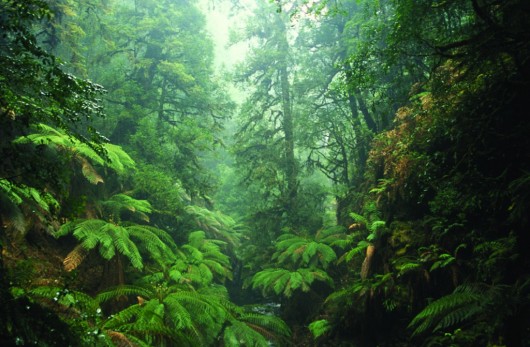 Arthur River Rainforest in Tasmania’s Tarkine
[Source: Photo by Ted Mead, ^http://tarkine.org/) Arthur River Rainforest in Tasmania’s Tarkine
[Source: Photo by Ted Mead, ^http://tarkine.org/)
.
.
Mar 2013: Savage River tailings spill exactly why we shouldn’t have new mines in the Tarkine
.
<The EPA announcement that an acid forming tailings spill has occurred at the Savage River Mine is evidence of the risks posed to the Tarkine by proposed new mines.
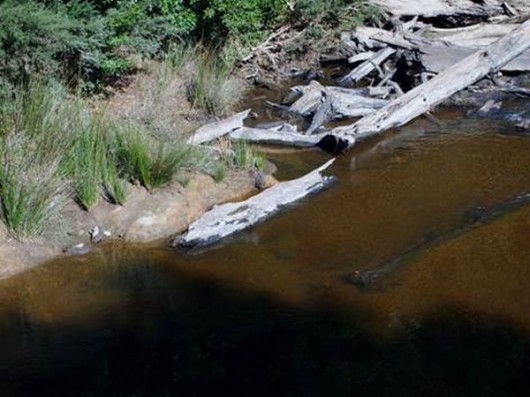 Savage River Mine tailings spill into Tasmania’s wild Pieman River
[Source: ‘‘I have never seen anything like it’, 20130325, by Isla MacGregor, Tasmanian Public and Environmental Health Network,
in Tasmanian Times, ^http://tasmaniantimes.com/index.php?/weblog/article/i-have-never-seen-anything-like-it/] Savage River Mine tailings spill into Tasmania’s wild Pieman River
[Source: ‘‘I have never seen anything like it’, 20130325, by Isla MacGregor, Tasmanian Public and Environmental Health Network,
in Tasmanian Times, ^http://tasmaniantimes.com/index.php?/weblog/article/i-have-never-seen-anything-like-it/]
.
Tarkine National Coalition Campaign Coordinator, Mr Scott Jordan:
“The mining industry has been telling us that modern mines are safe and environmentally sound, and yet here we have evidence that even with the best of intentions from an award winning operator, there is always unacceptable risks. Accidents can and will happen, and the environment will suffer the costs”.
TNC are urging a EPA to make their investigation transparent and to make the findings public. >>
.
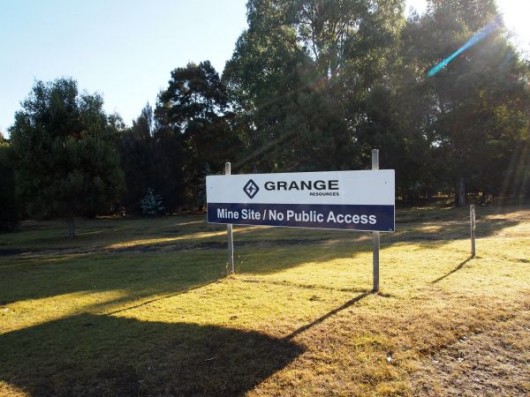 Grange Resources, Savage River Mine
Recklessly destroying and polluting The Tarkine
thanks to disinterested approval by selfish old men Babyboomer politicians in Hobart Grange Resources, Savage River Mine
Recklessly destroying and polluting The Tarkine
thanks to disinterested approval by selfish old men Babyboomer politicians in Hobart
.
Mar 2013: Statement of Reasons sought on Tarkine Heritage decision
.
<<Community advocate to save The Tarkine, the Tarkine National Coalition, has written to Federal Environment Minister Tony Burke and formally sought statement of reasons relating to the Tarkine National Heritage decision. The request is pursuant to Section 13 of the Administrative Decisions (Judicial Review) Act 1977.
Under the Act, upon request the Minister must provide a statement of reasons within 28 days of the request being made.
The TNC is still awaiting a statement of reasons relating to the Nelson Bay River mine approval, and last week instructed solicitors to write again to the Minister to alert him to his legal obligations.
Mr Scott Jordan:
“We have a view that the decision to not heritage list the Tarkine was not based on the evidence before the Minister. There are no documents that have been released supporting the case to not list the area, and so we are very keen to see the Minister’s reasons for this decision”.
The Australian Heritage Council recommended a 439,000 hectare National Heritage Listing.>>
.
 . .
Mar 2013: CNN names Tarkine first in CNN’s world’s last great wilderness areas
.
<<The Tarkine has been named first in CNN’s list of the world’s last great wilderness areas. Tarkine National Coalition has welcomed this international recognition of the Tarkine’s wilderness values.
Mr Scott Jordan:
“CNN has confirmed what we have known all along. The Tarkine is a remarkable and unique place that deserves to be listed as one of the worlds great wilderness assets. The challenge now is for our state and federal governments to ensure that the Tarkine is protected through National and World Heritage listing”.
Over the past decade the Tarkine has delivered on the jobs front, with visitor numbers and Tarkine related jobs growing even in the current national downturn.
“The Tarkine continues to grow it’s reputation as a premier tourist destination. The new mines proposed will kill the golden goose”.>>
.
Feb 2013: Watering down of mine permit conditions unacceptable
.
<<The Tarkine National Coalition has received written notice that Circular Head Council has “deleted” a permit condition aimed at providing protecting watercourses on the Nelson Bay River proposed mine site.
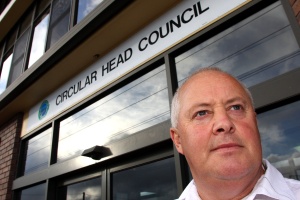 Circular Head Mayor Daryl Quilliam
(a Babyboomer…) Circular Head Mayor Daryl Quilliam
(a Babyboomer…)
.
The deleted condition stated ‘Apart from the creation of the site’s access, no building works or vegetation clearing shall occur within 30 metres of a watercourse’.
Mr Scott Jordan:
“Here we have a council who is hell bent on doing whatever it takes to get a mine up in the Arthur Pieman Conservation Area, and the environment be damned. The Nelson Bay River and it’s catchment creeks provide drinking water to local wildlife, including threatened species like the Tasmanian devil and Spotted tailed quoll. It also discharges just 5 km downstream into the shack community of Nelson Bay, a popular fishing and crayfishing location”.
“It appears the rules don’t apply if you are a mining company. Before they’ve even commenced operations Shree Minerals is calling the shots and dictating the rules”.
The Nelson bay River proposed mine sits within the area the Australian Heritage Council recommended as a 439,000 hectare Tarkine National Heritage Listing.>>
.
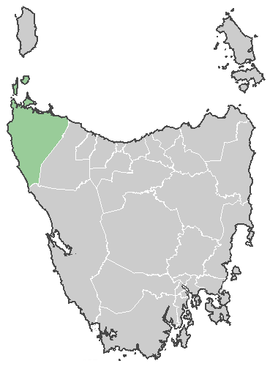
.
Feb 2013: Minister fails to comply with legal requests
.
<<Federal Environment Minister Tony Burke has failed to comply with a legal request for a Statement of reasons pursuant to Section 13 of the Administrative Decisions (Judicial Review) Act 1977. Tarkine National Coalition had formally sought statement of reasons relating to the EPBC approvals for the Nelson Bay River mine. ‘
Under the Act, upon request the Minister must provide a statement of reasons within 28 days of the request being made. This period expired on 18th February.
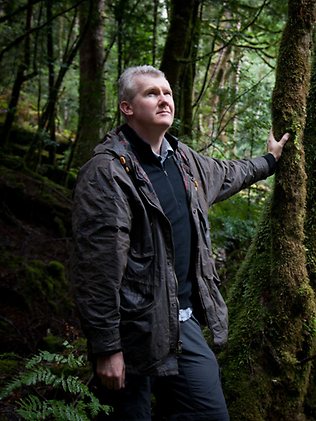 Federal Environment Minister Tony Burke Federal Environment Minister Tony Burke
.
The TNC has instructed solicitors to write again to the Minister to alert him to his legal obligation and again request the statement of reasons.
Mr Scott Jordan:
“There are serious concerns with the Minister’s complete disregard for the legal obligations of his portfolio. This combined with his inability to tell the truth leaves us with absolutely no confidence in this Minister”.
“The Minister made comment last night on ABC’s Lateline that the current Tasmanian Forest Agreement process would protect the Tarkine. The reserves proposed in this agreement would allow for new mining and exploration activity, a fact the Minister is aware of. He has kowtowed to the mining bosses and now wants to paint himself in a better light. Unfortunately the fact speak contrary to the Minister’s statements.”
Mr Jordan congratulated and thanked Australian Greens Senator Christine Milne for raising the plight of the Tarkine in her National Press Club address yesterday.
“Senator Milne has hit the nail on the head. Tony Burke is working against the public interest and for the mining bosses”.>>
.
 Mr Scott Jordan
Tarkine National Coalition
(Photo by Eliza Wood). Mr Scott Jordan
Tarkine National Coalition
(Photo by Eliza Wood).
.
[Source: Campaign Coordinator Scott Jordan, Tarkine National Coalition, PO Box 218, Burnie, Tasmania, 7320, ^http://tarkine.org/]
.
Tuesday, April 16th, 2013
 . .
<Federal environment minister Tony Burke has rejected National Heritage listing for Tasmania’s precious Tarkine Wilderness.
.
Burke’s Ten New Mines!
.
On 8th February 2013, Burke announced 10 new mines proposed over the next five years for the Tarkine Wilderness. Nine of these 10 mines will be open cut leaving scars of devastation in an area of north-western Tasmania.
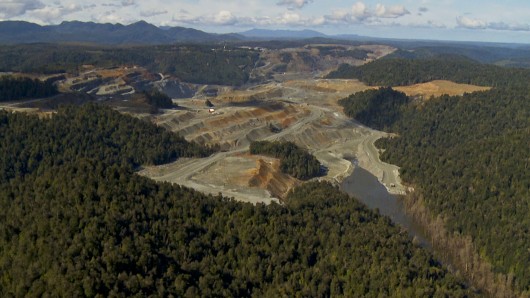 Savage River Mine already scarring The Tarkine Wilderness Savage River Mine already scarring The Tarkine Wilderness
.
“The Tarkine is one of the world’s great wild places.
It is an expansive 447,000 hectare wilderness area of recognised World Heritage significance in the North-West corner of Tasmania, Australia’s island state. The Tarkine contains remarkable natural and cultural values, including one of the world’s most significant remaining tracts of temperate rainforest,” said the Tarkine National Coalition.
The Tarkine is a place of unique natural and cultural significance and was nominated for World Heritage listing by the Australian Senate in 2007.
The Tarkine has been recognised by prominent bodies including the International Union for the Conservation of Nature, the Tasmanian Department of Parks, Wildlife and Heritage and environment groups such as The Wilderness Society and the Australian Conservation Foundation.
The Australian government has recognised the Tarkine’s outstanding national significance through listing the Tarkine on the register of the National estate.
As the Tarkine National Coalition says:
.
Burke only “listed a paltry 4% of the 433,000 hectares recommended to him by the inquiry”
.
Since February 8, Burke has granted the first two of 10 mining permits to Venture Minerals for three iron mines at Mount Lindsay and granted Shree Minerals an iron ore mine proposed for Nelson Bay River.
Successive environment ministers have failed to put forward an assessment by the Australian Heritage council for Heritage listing with UNESCO leaving these areas of “outstanding natural and cultural value” vulnerable to the policies of Burke.
A national day of action on 14th February 2013 and a campaign in local media helped to expose the plight of the now endangered Tarkine and reverse this environmentally catastrophic decision.
Venture Minerals and Shree Minerals are driven by the profits to be made from these proposed mining ventures in the Tarkine. But the Tarkine has far more long-term value as a wilderness area and should continue to benefit all.>>
.
[Source: ‘Mining approved in the Tarkine’, 20130219, by Rachel Christensen, ^http://www.greenleft.org.au/node/53374]
.
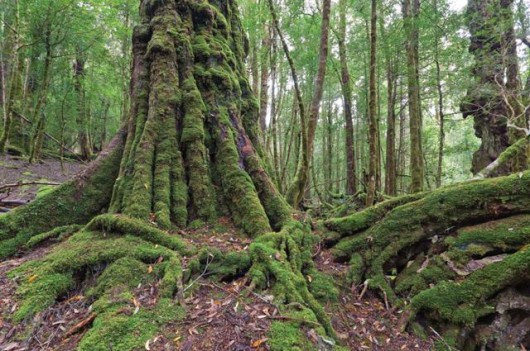 Tarkine Wilderness
(Peter Walton, Tasmania Expeditions) Tarkine Wilderness
(Peter Walton, Tasmania Expeditions)
.
So in the absence of government responsibility, Dr Bob Brown has just been announced as new patron of rebranded Save the Tarkine campaign.
The Tarkine National Coalition is pleased to make two exciting announcements that we believe will help increase the national profile of this important campaign.
“Today we are unveiling the new Save the Tarkine branding that we will campaign under”, announced Campaign Coordinator, Scott Jordan. “We believe that brand, Save the Tarkine will help the public more easily identify this important campaign, and let them know in clear terms what our mission is.”
To support this rebranding, a new Tasmanian devil inspired logo has been adopted (see above).
Tarkine National Coalition Incorporated remains as the registered legal entity, with campaigns to be conducted under the registered trading name Save the Tarkine.
Save the Tarkine are also thrilled to announce that Dr Bob Brown has accepted our invitation to become patron of the campaign.
“Bob is no stranger to the Tarkine, having fought for it’s protection both in and out of the parliament. We are thrilled that Bob has agreed to accept the role of patron, and we look forward to sharing Bob’s passion for the Tarkine with all of Australia”.
“I’m honoured to be first patron of Save the Tarkine”, said Dr Brown in Launceston. “I first walked the Tarkine forty years ago looking for Tasmanian Tigers, and if protected the Tarkine will create hundreds, if not thousands of jobs in the future. If mined it will end up another post-industrial waste dump”.
.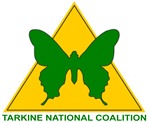 . .
 . .
<<The Tarkine is a vast, continuous and largely untouched wilderness of exceptional and rare diversity. Covering an area of around 450,000 hectares in Tasmania’s north-west, it is a place worthy of World Heritage protection yet, unbelievably, remains inadequately protected and vulnerable to being carved up by the mining and forestry industries.
This book is the authors’ tribute to this last of the last frontier experiences on earth.>>
.
‘Tarkine – Wild and Sacred’
by S & E Bartley
40 Degrees South Publishing
RRP:$29.95 Paperback 144 pp
ISBN 9780987243195
.
[Source/Purchase: ^http://www.fortysouth.com.au/writers-market/book/161]
.
Tags: Bob Brown, Mount Lindsay, Nelson Bay River, save the Tarkine, Shree Minerals, Tarkine wilderness, Tasmania, Tasmanian Tarkine, Tin Mining, Tony Burke, Venture Minerals
Posted in Tasmania (AU), Threats from Mining | 2 Comments »
Add this post to Del.icio.us - Digg
Monday, February 27th, 2012
This article is by Scott Jordan, Campaign Coordinator Tarkine National Coalition, initially entitled ‘Shree Minerals’ Impact Statement documentation critically non-compliant‘ dated 20120222..
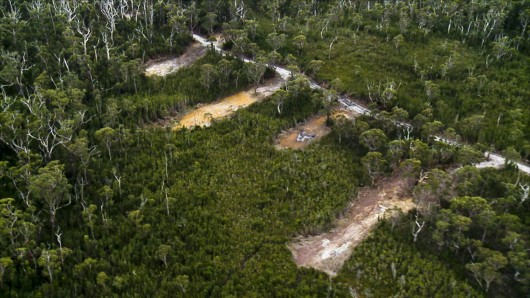 Shree Minerals – foreign miners pillaging Tasmania’s precious Tarkine wilderness
(Photo courtesy of Tarkine National Coalition, click photo to enlarge) Shree Minerals – foreign miners pillaging Tasmania’s precious Tarkine wilderness
(Photo courtesy of Tarkine National Coalition, click photo to enlarge)
.
Tarkine National Coalition has described the Shree Minerals’ Environmental Impact Statement (EIS) for the proposed Nelson Bay River open cut iron ore mine as a mismatch of omissions, flawed assumptions and misrepresentations.
Key data on endangered orchids is missing,
and projections on impacts on Tasmanian Devil and Spotted-tailed Quoll
are based on flawed and fanciful data.
 Spotted-tailed Quoll Spotted-tailed Quoll
.
The EIS produced by the company as part of the Commonwealth environmental assessments has failed to produce a report relating to endangered and critically endangered orchid populations in the vicinity of the proposed open cut mine. The soil borne Mychorizza fungus is highly succeptible to changes in hydrology, and is essential to the germination of the area’s native orchids which cannot exist without Mychorizza. Federal Environment Minister Tony Burke included this report as a requirement in the project’s EIS guidelines issued in June 2011.
 Australia’s Minister for Environment
Tony Burke Australia’s Minister for Environment
Tony Burke
.
“Shree Minerals have decided that undertaking the necessary work on the proposal is likely to uncover some inconvenient truths, and so instead of producing scientific reports they are asking us to suspend common sense and accept that a 220 metre deep hole extending 1km long will have no impact on hydrology.” said Tarkine National Coalition spokesperson Scott Jordan.
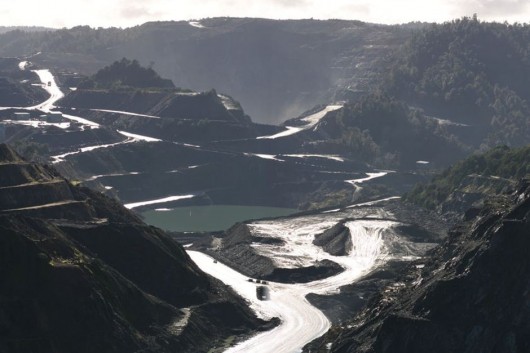 Utter devastation
A magnetite mine at nearby Savage River Utter devastation
A magnetite mine at nearby Savage River
.
“It’s a ridiculous notion when you consider that the mine depth will be some 170 metres below the level of the adjacent Nelson Bay River.”
TNC has also questioned the company’s motives in the clear contradictions and misrepresentations in the data relating to projections of Tasmanian devil roadkill from mine related traffic. The company has used a January-February traffic surveys as a current traffic baseline which skews the data due to the higher level of tourist, campers and shackowner during the traditional summer holiday season.
Department of Infrastructure, Energy and Resources (Tasmania) (DIER) data indicates that there is a doubling of vehicles on these road sections between October and January.
The company also asserted an assumed level of mine related traffic that is substantially lower than their own expert produced Traffic Impact Assessment.
The roadkill assumptions were made on an additional 82 vehicles per day in year one, and 34 vehicles per day in years 2-10, while the figures the Traffic Impact Assessment specify 122 vehicles per day in year one, and 89 vehicles per day in ongoing years.
“When you apply the expert Traffic Impact Assessment data and the DIER’s data for current road use, the increase in traffic is 329% in year one and 240% in years 2-10 which contradicts the company’s flawed projections of 89% and 34%”.
“This increase of traffic will, on the company’s formulae, result in up to 32 devil deaths per year, not the 3 per year in presented in the EIS.”
“Shree Minerals either is too incompetent to understand it’s own expert reports, or they have set out to deliberately mislead the Commonwealth and State environmental assessors.”
“Either way, they are unfit to be trusted with a Pilbara style iron ore mine in stronghold of threatened species like the Tarkine.”
The public comment period closed on Monday, and the company now has to compile public comments received and submit them with the EIS to the Commonwealth.
.
 . .
Discovery of Tasmanian devil facial tumour disease in the Tarkine
Media Release 20120224
.
Tarkine National Coalition has described the discovery of Tasmanian Devil Facial Tumour Disease (DFTD) at Mt Lindsay in the Tarkine as a tragedy.
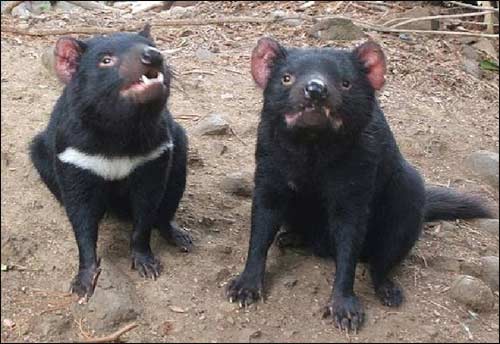
“The Tarkine has been for a number of years the last bastion of disease free devils, and news that the disease has been found in the south eastern zone of the Tarkine is devastating news”, said Tarkine National Coalition spokesperson Scott Jordan.
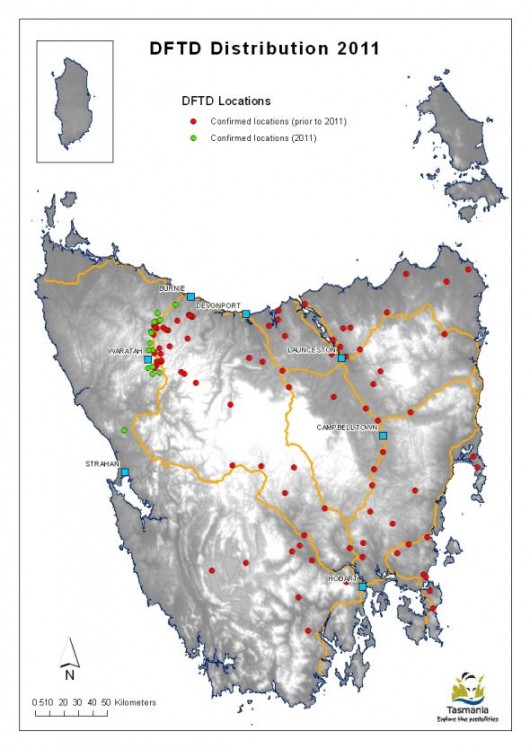
“It is now urgent that the federal and state governments step up and take immediate action to prevent any factors that may exacerbate or accelerate the transmission of this disease to the remaining healthy populations in the Tarkine”.
“The decisions made today will have a critical impact on the survival of the Devil in the wild. Delay is no longer an option – today is the day for action.”
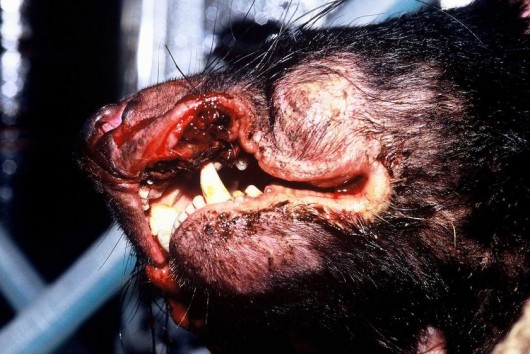
“They should start by reinstating the Emergency National Heritage Listing and placing an immediate halt on all mineral exploration activity in the Tarkine to allow EPBC assessments.”
.
NOTE: EPBC stands for Australia’s Environment Protection and Biodiversity Conservation Act 1999
.
.
 . .
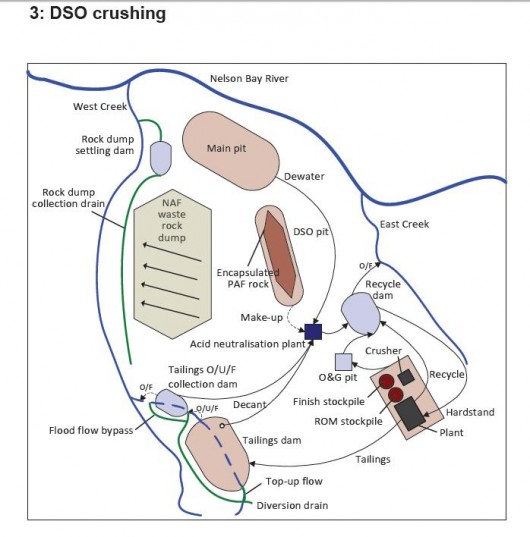 Proposed Mine Site Plan (Direct Shipping Ore) with flows to enter tributaries of Nelson River
(Source: Shree Minerals EIS, 2011) Proposed Mine Site Plan (Direct Shipping Ore) with flows to enter tributaries of Nelson River
(Source: Shree Minerals EIS, 2011)
.
“The Nelson Bay Iron Ore Project (ELs 41/2004 & 54/2008) covers the Nelson Bay Magnetite deposit with Inferred Mineral Resources reported to Australasian Joint Ore Reserves Committee (JORC) guidelines. Drilling will look to enlarge the deposit and improve the quality of the resource, currently standing at 6.8 Million tonnes @ 38.2% magnetite at a 20% magnetite cut off. In addition exploration work will look follow up recent drilling of near surface iron oxide mineralisation in an attempt delineate direct shipping ore. Exploration of additional magnetic targets will also be undertaken.”
[Source: Shree Minerals website, ^http://www.shreeminerals.com/shreemin/scripts/page.asp?mid=16&pageid=27]
.
The Irreversible Ecological Damage of Long Wall Mining
.
‘Impacts of Longwall Coal Mining on The Environment‘ >Read Report (700kb)
[Source: Total Environment Centre, NSW, 2007, ^http://www.tec.org.au/component/docman/doc_view/201-longwall-rep07]
.
Mining Experience in New South Wales – Waratah Rivulet
[Source: ^http://riverssos.org.au/mining-in-nsw/waratah-rivulet/]
.
The image belows show the shocking damage caused by longwall coal mining to the Waratah Rivulet, which flows into Woronora Dam.
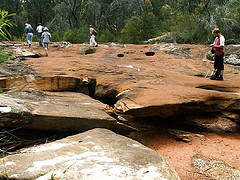
Longwalls have run parallel to and directly under this once pristine waterway in the Woronora Catchment Special Area. You risk an $11,000 fine if you set foot in the Catchment without permission, yet coal companies can cause irreparable damage like this and get away with it.
Waratah Rivulet is a third order stream that is located just to the west of Helensburgh and feeds into the Woronora Dam from the south. Along with its tributaries, it makes up about 29% of the Dam catchment. The Dam provides both the Sutherland Shire and Helensburgh with drinking water. The Rivulet is within the Sydney Catchment Authority managed Woronora Special Area there is no public access without the permission of the SCA. Trespassers are liable to an $11,000 fine.
.
Longwall Mining under Waratah Rivulet
Metropolitan Colliery operates under the Woronora Special Area. Excel Coal operated it until October 2006 when Peabody Energy, the world’s largest coal mining corporation, purchased it. The method of coal extraction is longwall mining. Recent underground operations have taken place and still are taking place directly below the Waratah Rivulet and its catchment area.
In 2005 the NSW Scientific Committee declared longwall mining to be a key threatening process (read report below). The Waratah Rivulet was listed in the declaration along with several other rivers and creeks as being damaged by mining. No threat abatement plan was ever completed.
In September 2006, conservation groups were informed that serious damage to the Waratah Rivulet had taken place. Photographs were provided and an inspection was organised through the Sydney Catchment Authority (SCA) to take place on the 24th of November. On November 23rd, the Total Environment Centre met with Peabody Energy at the mining company’s request. They had heard of our forthcoming inspection and wanted to tell us about their operation and future mining plans. Through a PowerPoint presentation they told us we would be shocked by what we would see and that water had drained from the Rivulet but was reappearing further downstream closer to the dam.
The inspection took place on the 24th of November and was attended by officers from the SCA and the Department of Environment and Conservation (DEC), the Total Environment Centre, Colong Foundation, Rivers SOS and two independent experts on upland swamps and sandstone geology. We walked the length of the Rivulet that flows over the longwall panels. Although, similar waterways in the area are flowing healthily, the riverbed was completely dry for much of its length. It had suffered some of the worst cracking we had ever seen as a result of longwall mining. The SCA officers indicated that at one series of pools, water levels had dropped about 3m. We were also told there is anecdotal evidence suggesting the Rivulet has ceased to pass over places never previously known to have stopped flowing.
It appeared that the whole watercourse had tilted to the east as a result of the subsidence and upsidence. Rock ledges that were once flat now sloped. Iron oxide pollution stains were also present. The SCA also told us that they did not know whether water flows were returning further downstream. There was also evidence of failed attempts at remediation with a distinctly different coloured sand having washed out of cracks and now sitting on the dry river bed or in pools.
Also undermined was Flat Rock Swamp at the southernmost extremity of the longwall panels. It is believed to be the main source of water recharge for the Waratah Rivulet. It is highly likely that the swamp has also been damaged and is sitting on a tilt.
TEC has applied under Freedom of Information legislation to the SCA for documents that refer to the damage to the Waratah Rivulet.
During the meeting with Peabody on 23rd November, the company stated its intentions sometime in 2007 to submit a 3A application under the EP&A Act 1974 (NSW) to mine a further 27 longwall panels that will run under the Rivulet and finish under the Woronora Dam storage area.
This is very alarming given the damage that has already occurred to a catchment that provides the Sutherland Shire & Helensburgh with 29% of their drinking water. The dry bed of Waratah Rivulet above the mining area and the stain of iron oxide pollution may be seen clearly through Google Earth.
.
The Bigger Picture
In 2005 Rivers SOS, a coalition of 30 groups, formed with the aim of campaigning for the NSW Government to mandate a safety zone of at least 1km around rivers and creeks threatened by mining in NSW.
The peak environment groups of NSW endorse this position and it forms part of their election policy document.
.
Longwall Mining under or close to Rivers and Streams:
.
Seven major rivers and numerous creeks in NSW have been permanently damaged by mining operations which have been allowed to go too close to, or under, riverbeds. Some rivers are used as channels for saline and acid wastewater pumped out from mines. Many more are under threat. The Minister for Primary Industries, Ian Macdonald, is continuing to approve operations with the Department of Planning and DEC also involved in the process, as are a range of agencies (EPA, Fisheries, DIPNR, SCA, etc.) on an Interagency Review Committee. This group gives recommendations concerning underground mine plans to Ian Macdonald, but has no further say in his final decision. A document recently obtained under FOI by Rivers SOS shows that an independent consultant to the Interagency Committee recommended that mining come no closer than 350m to the Cataract River, yet the Minister approved mining to come within 60m.
The damage involves multiple cracking of river bedrock, ranging from hairline cracks to cracks up to several centimetres wide, causing water loss and pollution as ecotoxic chemicals are leached from the fractured rocks.
.
Aquifers may often be breached.
.
Satisfactory remediation is not possible. In addition, rockfalls along mined river gorges are frequent. The high price of coal and the royalties gained from expanding mines are making it all too tempting for the Government to compromise the integrity of our water catchments and sacrifice natural heritage.
.
Longwall Mining in the Catchments
.
Longwall coal mining is taking place across the catchment areas south of Sydney and is also proposed in the Wyong catchment. Of particular concern is BHP-B’s huge Dendrobium mine which is undermining the Avon and Cordeaux catchments, part of Sydney’s water supply.
A story in the Sydney Morning Herald in January 2005 stated that the SCA were developing a policy for longwall coal mining within the catchments that would be ready by the middle of that year. This policy is yet to materialise.
The SMP approvals process invariably promises remediation and further monitoring. But damage to rivers continues and applications to mine areapproved with little or no significant conditions placed upon the licence.
Remediation involves grouting some cracks but cannot cover all of the cracks, many of which go undetected, in areas where the riverbed is sandy for example.
Sometimes the grout simply washes out of the crack, as is the case in the Waratah Rivulet.
The SCA was established as a result of the 1998 Sydney water crisis. Justice Peter McClellan, who led the subsequent inquiry, determined that a separate catchment management authority with teeth should be created because, as he said “someone should wake up in the morning owning the issue” of adequate management.
An audit of the SCA and the catchments in 1999 found multiple problems including understaffing, the need to interact with so many State agencies, and enormous pressure from developers. Developers in the catchments include mining companies. In spite of government policies such as SEPP 58, stating that development in catchments should have only a “neutral or beneficial effect” on water quality, longwall coal mining in the catchments have been, and are being, approved by the NSW government.
Overidden by the Mining Act 1992, the SCA appears powerless to halt the damage to Sydney’s water supply.
.
Alteration of habitat following subsidence due to longwall mining – key threatening process listing
[Source: ‘Alteration of habitat following subsidence due to longwall mining – key threatening process listing’, Dr Lesley Hughes, ChairpersonScientific Committee, Proposed Gazettal date: 15/07/05, Exhibition period: 15/07/05 – 09/09/05on Department of Environment (NSW) website,^http://www.environment.nsw.gov.au/determinations/LongwallMiningKtp.htm]
.
NSW Scientific Committee – final determination
.
The Scientific Committee, established by the Threatened Species Conservation Act, has made a Final Determination to list Alteration of habitat following subsidence due to longwall mining as a KEY THREATENING PROCESS in Schedule 3 of the Act. Listing of key threatening processes is provided for by Part 2 of the Act.
.
The Scientific Committee has found that:
1. Longwall mining occurs in the Northern, Southern and Western Coalfields of NSW. The Northern Coalfields are centred on the Newcastle-Hunter region. The Southern Coalfield lies principally beneath the Woronora, Nepean and Georges River catchments approximately 80-120 km SSW of Sydney. Coalmines in the Western Coalfield occur along the western margin of the Sydney Basin. Virtually all coal mining in the Southern and Western Coalfields is underground mining.
2. Longwall mining involves removing a panel of coal by working a face of up to 300 m in width and up to two km long. Longwall panels are laid side by side with coal pillars, referred to as “chain pillars” separating the adjacent panels. Chain pillars generally vary in width from 20-50 m wide (Holla and Barclay 2000). The roof of the working face is temporarily held up by supports that are repositioned as the mine face advances (Karaman et al. 2001). The roof immediately above the coal seam then collapses into the void (also known as the goaf) and a collapse zone is formed above the extracted area. This zone is highly fractured and permeable and normally extends above the seam to a height of five times the extracted seam thickness (typical extracted seam thickness is approximately 2-3.5 m) (ACARP 2002). Above the collapse zone is a fractured zone where the permeability is increased to a lesser extent than in the collapse zone. The fractured zone extends to a height above the seam of approximately 20 times the seam thickness, though in weaker strata this can be as high as 30 times the seam thickness (ACARP 2002). Above this level, the surface strata will crack as a result of bending strains, with the cracks varying in size according to the level of strain, thickness of the overlying rock stratum and frequency of natural joints or planes of weakness in the strata (Holla and Barclay 2000).
3. The principal surface impact of underground coal mining is subsidence (lowering of the surface above areas that are mined) (Booth et al. 1998, Holla and Barclay 2000). The total subsidence of a surface point consists of two components, active and residual. Active subsidence, which forms 90 to 95% of the total subsidence in most cases, follows the advance of the working face and usually occurs immediately. Residual subsidence is time-dependent and is due to readjustment and compaction within the goaf (Holla and Barclay 2000). Trough-shaped subsidence profiles associated with longwall mining develop tilt between adjacent points that have subsided different amounts.
Maximum ground tilts are developed above the edges of the area of extraction and may be cumulative if more than one seam is worked up to a common boundary. The surface area affected by ground movement is greater than the area worked in the seam (Bell et al. 2000). In the NSW Southern Coalfield, horizontal displacements can extend for more than one kilometre from mine workings (and in extreme cases in excess of three km) (ACARP 2002, 2003), although at these distances, the horizontal movements have little associated tilt or strain. Subsidence at a surface point is due not only to mining in the panel directly below the point, but also to mining in the adjacent panels. It is not uncommon for mining in each panel to take a year or so and therefore a point on the surface may continue to experience residual subsidence for several years (Holla and Barclay 2000).
4. The degree of subsidence resulting from a particular mining activity depends on a number of site specific factors. Factors that affect subsidence include the design of the mine, the thickness of the coal seam being extracted, the width of the chain pillars, the ratio of the depth of overburden to the longwall panel width and the nature of the overlying strata; sandstones are known to subside less than other substrates such as shales. Subsidence is also dependent on topography, being more evident in hilly terrain than in flat or gently undulating areas (Elsworth and Liu 1995, Holla 1997, Holla and Barclay 2000, ACARP 2001). The extent and width of surface cracking over and within the vicinity of the mined goaf will also decrease with an increased depth of mining (Elsworth and Liu 1995).
5. Longwall mining can accelerate the natural process of ‘valley bulging’ (ACARP 2001, 2002). This phenomenon is indicated by an irregular upward spike in an otherwise smooth subsidence profile, generally co-inciding with the base of the valley. The spike represents a reduced amount of subsidence, known as ‘upsidence’, in the base and sides of the valley and is generally coupled with the horizontal closure of the valley sides (ACARP 2001, 2002). In most cases, the upsidence effects extend outside the valley and include the immediate cliff lines and ground beyond them (ACARP 2002).
6. Mining subsidence is frequently associated with cracking of valley floors and creeklines and with subsequent effects on surface and groundwater hydrology (Booth et al. 1998, Holla and Barclay 2000, ACARP 2001, 2002, 2003). Subsidence-induced cracks occurring beneath a stream or other surface water body may result in the loss of water to near-surface groundwater flows.
If the water body is located in an area where the coal seam is less than approximately 100-120 m below the surface, longwall mining can cause the water body to lose flow permanently. If the coal seam is deeper than approximately 150 m, the water loss may be temporary unless the area is affected by severe geological disturbances such as strong faulting. In the majority of cases, surface waters lost to the sub-surface re-emerge downstream. The ability of the water body to recover is dependent on the width of the crack, the surface gradient, the substrate composition and the presence of organic matter. An already-reduced flow rate due to drought conditions or an upstream dam or weir will increase the impact of water loss through cracking. The potential for closure of surface cracks is improved at sites with a low surface gradient although even temporary cracking, leading to loss of flow, may have long-term effects on ecological function in localised areas. The steeper the gradient, the more likely that any solids transported by water flow will be moved downstream allowing the void to remain open and the potential loss of flows to the subsurface to continue.
A lack of thick alluvium in the streambed may also prolong stream dewatering (by at least 13 years, in one case study in West Virginia, Gill 2000).
Impacts on the flows of ephemeral creeks are likely to be greater than those on permanent creeks (Holla and Barclay 2000). Cracking and subsequent water loss can result in permanent changes to riparian community structure and composition.
7. Subsidence can also cause decreased stability of slopes and escarpments, contamination of groundwater by acid drainage, increased sedimentation, bank instability and loss, creation or alteration of riffle and pool sequences, changes to flood behaviour, increased rates of erosion with associated turbidity impacts, and deterioration of water quality due to a reduction in dissolved oxygen and to increased salinity, iron oxides, manganese, and electrical conductivity (Booth et al. 1998, Booth and Bertsch 1999, Sidle et al. 2000, DLWC 2001, Gill 2000, Stout 2003). Displacement of flows may occur where water from mine workings is discharged at a point or seepage zone remote from the stream, and in some cases, into a completely different catchment. Where subsidence cracks allow surface water to mix with subsurface water, the resulting mixture may have altered chemical properties. The occurrence of iron precipitate and iron-oxidising bacteria is particularly evident in rivers where surface cracking has occurred. These bacteria commonly occur in Hawkesbury Sandstone areas, where seepage through the rock is often rich in iron compounds (Jones and Clark 1991) and are able to grow in water lacking dissolved oxygen. Where the bacteria grow as thick mats they reduce interstitial habitat, clog streams and reduce available food (DIPNR 2003). Loss of native plants and animals may occur directly via iron toxicity, or indirectly via smothering. Long-term studies in the United States indicate that reductions in diversity and abundance of aquatic invertebrates occur in streams in the vicinity of longwall mining and these effects may still be evident 12 years after mining (Stout 2003, 2004).
8. The extraction of coal and the subsequent cracking of strata surrounding the goaf may liberate methane, carbon dioxide and other gases. Most of the gas is removed by the ventilation system of the mine but some gas remains within the goaf areas. Gases tend to diffuse upwards through any cracks occurring in the strata and be emitted from the surface (ACARP 2001). Gas emissions can result in localised plant death as anaerobic conditions are created within the soil (Everett et al. 1998).
9. Subsidence due to longwall mining can destabilise cliff-lines and increase the probability of localised rockfalls and cliff collapse (Holla and Barclay 2000, ACARP 2001, 2002). This has occurred in the Western Coalfield and in some areas of the Southern Coalfield (ACARP 2001). These rockfalls have generally occurred within months of the cliffline being undermined but in some cases up to 18 years after surface cracking first became visible following mining (ACARP 2001). Changes to cliff-line topography may result in an alteration to the environment of overhangs and blowouts. These changes may result in the loss of roosts for bats and nest sites for cliff-nesting birds.
10. Damage to some creek systems in the Hunter Valley has been associated with subsidence due to longwall mining. Affected creeks include Eui Creek, Wambo Creek, Bowmans Creek, Fishery Creek and Black Creek (Dept of Sustainable Natural Resources 2003, in lit.). Damage has occurred as a result of loss of stability, with consequent release of sediment into the downstream environment, loss of stream flow, death of fringing vegetation, and release of iron rich and occasionally highly acidic leachate. In the Southern Coalfields substantial surface cracking has occurred in watercourses within the Upper Nepean, Avon, Cordeaux, Cataract, Bargo, Georges and Woronora catchments, including Flying Fox Creek, Wongawilli Creek, Native Dog Creek and Waratah Rivulet. The usual sequence of events has been subsidence-induced cracking within the streambed, followed by significant dewatering of permanent pools and in some cases complete absence of surface flow.
11. The most widely publicised subsidence event in the Southern Coalfields was the cracking of the Cataract riverbed downstream of the Broughtons Pass Weir to the confluence of the Nepean River. Mining in the vicinity began in 1988 with five longwall panels having faces of 110 m that were widened in 1992 to 155 m. In 1994, the river downstream of the longwall mining operations dried up (ACARP 2001, 2002). Water that re-emerged downstream was notably deoxygenated and heavily contaminated with iron deposits; no aquatic life was found in these areas (Everett et al. 1998). In 1998, a Mining Wardens Court Hearing concluded that 80% of the drying of the Cataract River was due to longwall mining operations, with the balance attributed to reduced flows regulated by Sydney Water. Reduction of the surface river flow was accompanied by release of gas, fish kills, iron bacteria mats, and deterioration of water quality and instream habitat. Periodic drying of the river has continued, with cessation of flow recorded on over 20 occasions between June 1999 and October 2002 (DIPNR 2003). At one site, the ‘Bubble Pool”, localised water loss up to 4 ML/day has been recorded (DIPNR 2003).
Piezometers indicated that there was an unusually high permeability in the sandstone, indicating widespread bedrock fracturing (DIPNR 2003). High gas emissions within and around areas of dead vegetation on the banks of the river have been observed and it is likely that this dieback is related to the generation of anoxic conditions in the soil as the migrating gas is oxidised (Everett et al. 1998). An attempt to rectify the cracking by grouting of the most severe crack in 1999 was only partially successful (AWT 2000). In 2001, water in the Cataract River was still highly coloured, flammable gas was still being released and flow losses of about 50% (3-3.5 ML/day) still occurring (DLWC 2001). Environmental flow releases of 1.75 ML/day in the Cataract River released from Broughtons Pass Weir were not considered enough to keep the river flowing or to maintain acceptable water quality (DIPNR 2003).
12. Subsidence associated with longwall mining has contributed to adverse effects (see below) on upland swamps. These effects have been examined in most detail on the Woronora Plateau (e.g. Young 1982, Gibbins 2003, Sydney Catchment Authority, in lit.), although functionally similar swamps exist in the Blue Mountains and on Newnes Plateau and are likely to be affected by the same processes. These swamps occur in the headwaters of the Woronora River and O’Hares Creek, both major tributaries of the Georges River, as well as major tributaries of the Nepean River, including the Cataract and Cordeaux Rivers. The swamps are exceptionally species rich with up to 70 plant species in 15 m2 (Keith and Myerscough 1993) and are habitats of particular conservation significance for their biota. The swamps occur on sandstone in valleys with slopes usually less than ten degrees in areas of shallow, impervious substrate formed by either the bedrock or clay horizons (Young and Young 1988). The low gradient, low discharge streams cannot effectively flush sediment so they lack continuous open channels and water is held in a perched water table. The swamps act as water filters, releasing water slowly to downstream creek systems thus acting to regulate water quality and flows from the upper catchment areas (Young and Young 1988).
13. Upland swamps on the Woronora Plateau are characterised by ti-tree thicket, cyperoid heath, sedgeland, restioid heath and Banksia thicket with the primary floristic variation being related to soil moisture and fertility (Young 1986, Keith and Myerscough 1993). Related swamp systems occur in the upper Blue Mountains including the Blue Mountains Sedge Swamps (also known as hanging swamps) which occur on steep valley sides below an outcropping claystone substratum and the Newnes Plateau Shrub Swamps and Coxs River Swamps which are also hydrologically dependent on the continuance of specific topographic and geological conditions (Keith and Benson 1988, Benson and Keith 1990). The swamps are subject to recurring drying and wetting, fires, erosion and partial flushing of the sediments (Young 1982, Keith 1991). The conversion of perched water table flows into subsurface flows through voids, as a result of mining-induced subsidence may significantly affect the water balance of upland swamps (eg Young and Wray 2000). The scale of this impact is currently unknown, however, changes in vegetation may not occur immediately. Over time, areas of altered hydrological regime may experience a modification to the vegetation community present, with species being favoured that prefer the new conditions. The timeframe of these changes is likely to be long-term. While subsidence may be detected and monitored within months of a mining operation, displacement of susceptible species by those suited to altered conditions is likely to extend over years to decades as the vegetation equilibrates to the new hydrological regime (Keith 1991, NPWS 2001). These impacts will be exacerbated in periods of low flow. Mine subsidence may be followed by severe and rapid erosion where warping of the swamp surface results in altered flows and surface cracking creates nick-points (Young 1982). Fire regimes may also be altered, as dried peaty soils become oxidised and potentially flammable (Sydney Catchment Authority, in lit.) (Kodela et al. 2001).
14. The upland swamps of the Woronora Plateau and the hanging swamps of the Blue Mountains provide habitat for a range of fauna including birds, reptiles and frogs. Reliance of fauna on the swamps increases during low rainfall periods. A range of threatened fauna including the Blue Mountains Water Skink, Eulamprus leuraensis, the Giant Dragonfly, Petalura gigantea, the Giant Burrowing Frog, Heleioporus australiacus, the Red-crowned Toadlet, Pseudophryne australis, the Stuttering Frog Mixophyes balbus and Littlejohn’s Tree Frog, Litoria littlejohni, are known to use the swamps as habitat. Of these species, the frogs are likely to suffer the greatest impacts as a result of hydrological change in the swamps because of their reliance on the water within these areas either as foraging or breeding habitat. Plant species such as Persoonia acerosa, Pultenaea glabra, P. aristata and Acacia baueri ssp. aspera are often recorded in close proximity to the swamps.
Cliffline species such as Epacris hamiltonii and Apatophyllum constablei that rely on surface or subsurface water may also be affected by hydrological impacts on upland swamps, as well as accelerated cliff collapse associated with longwall mining.
15. Flora and fauna may also be affected by activities associated with longwall mining in addition to the direct impacts of subsidence. These activities include clearing of native vegetation and removal of bush rock for surface facilities such as roads and coal wash emplacement and discharge of mine water into swamps and streams. Weed invasion, erosion and siltation may occur following vegetation clearing or enrichment by mine water. Clearing of native vegetation, Bushrock removal, Invasion of native plant communities by exotic perennial grasses and Alteration to the natural flow regimes of rivers and streams and their floodplains and wetlands are listed as Key Threatening Processes under the Threatened Species Conservation Act (1995).
.
The following threatened species and ecological communities are known to occur in areas affected by subsidence due to longwall mining and their habitats are likely to be altered by subsidence and mining-associated activities:
Endangered Species
- Epacris hamiltonii a shrub
- Eulamprus leuraensis Blue Mountains Water Skink
- Hoplocephalus bungaroides Broad-headed Snake
- Isoodon obesulus Southern Brown Bandicoot
- Petalura gigantea Giant Dragonfly
.
Vulnerable species
- Acacia baueri subsp. aspera
- Apatophyllum constablei
- Boronia deanei
- Cercartetus nanus Eastern Pygmy Possum
- Epacris purpurascens var. purpurascens
- Grevillea longifolia
- Heleioporus australiacus Giant Burrowing Frog
- Ixobrychus flavicollis Black Bittern
- Leucopogon exolasius
- Litoria littlejohni Littlejohn’s Tree Frog
- Melaleuca deanei
- Mixophyes balbus Stuttering Frog
- Myotis adversus Large-footed Myotis
- Persoonia acerosa
- Potorous tridactylus Long-nosed Potoroo
- Pseudophryne australis Red-crowned Toadlet
- Pteropus poliocephalus Grey-headed Flying Fox
- Pterostylis pulchella
- Pultenaea aristata
- Pultenaea glabra
- Tetratheca juncea
- Varanus rosenbergi Rosenberg’s Goanna
.
Endangered Ecological Communities
.
- Genowlan Point Allocasuarina nana Heathland
- Newnes Plateau Shrub Swamp in the Sydney Basin Bioregion
- O’Hares Creek Shale Forest
- Shale/Sandstone Transition Forest
.
Species and populations of species not currently listed as threatened but that may become so as a result of habitat alteration following subsidence due to longwall mining include:
- Acacia ptychoclada
- Almaleea incurvata
- Darwinia grandiflora
- Dillwynia stipulifera
- Epacris coricea
- Grevillea acanthifolia subsp. acanthifolia
- Hydromys chrysogaster Water rat
- Lomandra fluviatilis
- Olearia quercifolia
- Pseudanthus pimelioides
.
16. Mitigation measures to repair cracking creek beds have had only limited success and are still considered experimental (ACARP 2002). Cracks less than 10 mm wide may eventually reseal without active intervention provided there is a clay fraction in the soil and at least some water flow is maintained.
Cracks 10-50 mm wide may be sealed with a grouting compound or bentonite.
Cracks wider than 50 mm require concrete (ACARP 2002). Pattern grouting in the vicinity of Marhnyes Hole in the Georges River has been successful at restoring surface flows and reducing pool drainage following fracturing of the riverbed (International Environmental Consultants 2004). Grouting of cracks also appears to have been relatively effective in Wambo Creek in the Hunter Valley. Installation of a grout curtain in the Cataract River, however, has been only partially successful and it was concluded in 2002, after rehabilitation measures had taken place, that the environment flows released from Broughtons Pass Weir by the Sydney Catchment Authority were insufficient to keep the Cataract River flowing or to maintain acceptable water quality (DIPNR 2003). Mitigation measures themselves may have additional environmental impacts due to disturbance from access tracks, the siting of drilling rigs, removal of riparian vegetation, and unintended release of the grouting material into the water. Furthermore, even measures that are successful in terms of restoring flows involve temporary rerouting of surface flows while mitigation is carried out (generally for 2-3 weeks at each grouting site). Planning for remediation measures may also be hampered by the lack of predictability of some impacts, and difficulties gaining access to remote areas where remedial works are needed. The long-term success of mitigation measures such as grouting is not yet known. It is possible that any ongoing subsidence after grouting may reopen cracks or create new ones.
Further, it is not yet known whether the clay substance bentonite, which is often added to the cement in the grouting mix, is sufficiently stable to prevent shrinkage. Grouting under upland and hanging swamps that have no definite channel is probably not feasible.
17. Empirical methods have been developed from large data sets to predict conventional subsidence effects (ACARP 2001, 2002, 2003). In general, these models have proved more accurate when predicting the potential degree of subsidence in flat or gently undulating terrain than in steep topography (ACARP 2003). A major issue identified in the ACARP (2001, 2002) reports was the lack of knowledge about horizontal stresses in geological strata, particularly those associated with river valleys. These horizontal stresses appear to play a major role in the magnitude and extent of surface subsidence impacts. The cumulative impacts of multiple panels also appear to have been poorly monitored. The general trend in the mining industry in recent years toward increased panel widths (from 200 up to 300 m), which allows greater economies in the overall costs of extraction, means that future impacts will tend to be greater than those in the past (ACARP 2001, 2002).
18. In view of the above the Scientific Committee is of the opinion that Alteration of habitat following subsidence due to longwall mining adversely affects two or more threatened species, populations or ecological communities, or could cause species, populations or ecological communities that are not threatened to become threatened.
.
References
.
ACARP (2001) ‘Impacts of Mine Subsidence on the Strata & Hydrology of River Valleys – Management Guidelines for Undermining Cliffs, Gorges and River Systems’. Australian Coal Association Research Program Final Report C8005 Stage 1, March 2001.
ACARP (2002) ‘Impacts of Mine Subsidence on the Strata & Hydrology of River Valleys – Management Guidelines for Undermining Cliffs, Gorges and River Systems’. Australian Coal Association Research Program Final Report C9067 Stage 2, June 2002.
ACARP (2003) ‘Review of Industry Subsidence Data in Relation to the Influence of Overburden Lithology on Subsidence and an Initial Assessment of a Sub-Surface Fracturing Model for Groundwater Analysis’. Australian Coal Association Research Program Final Report C10023, September 2003.
AWT (2000) ‘Investigation of the impact of bed cracking on water quality in the Cataract River.’ Prepared for the Dept. of Land and Water Conservation Sydney South Coast Region. AWT Report no. 2000/0366.
Bell FG, Stacey TR, Genske DD (2000) Mining subsidence and its effect on the environment: some differing examples. Environmental Geology 40, 135-152.
Benson DH, Keith DA (1990) The natural vegetation of the Wallerawang 1:100,000 map sheet. Cunninghamia 2, 305-335.
Booth CJ, Bertsch LP (1999) Groundwater geochemistry in shallow aquifers above longwall mines in Illinois, USA. Hydrogeology Journal 7, 561-575.
Booth CJ, Spande ED, Pattee CT, Miller JD, Bertsch LP (1998) Positive and negative impacts of longwall mine subsidence on a sandstone aquifer.
Environmental Geology 34, 223-233.
DIPNR (2003) ‘Hydrological and water quality assessment of the Cataract River; June 1999 to October 2002: Implications for the management of longwall coal mining.’ NSW Department of Infrastructure, Planning and Environment, Wollongong.
DLWC (2001) ‘Submission to the Commission of Inquiry into the Proposed Dendrobium Underground Coal Mine Project by BHP Steel (AIS) Pty Ltd, Wollongong, Wingecarribee & Wollondilly Local Government Areas’. Department of Land and Water Conservation, July 2001.
Elsworth D, Liu J (1995) Topographic influence of longwall mining on ground-water supplies. Ground Water 33, 786-793.
Everett M, Ross T, Hunt G (eds) (1998) ‘Final Report of the Cataract River Taskforce. A report to the Upper Nepean Catchment Management Committee of the studies of water loss in the lower Cataract River during the period 1993 to 1997.’ Cataract River Taskforce, Picton.
Gibbins L (2003) A geophysical investigation of two upland swamps, Woronora Plateau, NSW, Australia. Honours Thesis, Macquarie University.
Gill DR (2000) Hydrogeologic analysis of streamflow in relation to undergraound mining in northern West Virginia. MSc thesis, West Virginia University, Morgantown, West Virginia.
Holla L (1997) Ground movement due to longwall mining in high relief areas in New South Wales, Australia. International Journal of Rock Mechanics and Mining Sciences 34, 775-787.
Holla L, Barclay E (2000) ‘Mine subsidence in the Southern Coalfield, NSW, Australia’. Mineral Resources of NSW, Sydney.
International Environmental Consultants Pty Ltd (2004) ‘Pattern grouting remediation activities: Review of Environmental Effects Georges River Pools 5-22. May, 2004’.
Jones DC, Clark NR (eds) (1991) Geology of the Penrith 1:100,000 Sheet 9030, NSW. Geological Survey, NSW Department of Minerals and Energy.
Karaman A, Carpenter PJ, Booth CJ (2001) Type-curve analysis of water-level changes induced by a longwall mine. Environmental Geology 40, 897-901.
Keith DA (1991) Coexistence and species diversity in upland swamp vegetation. PhD thesis. University of Sydney.
Keith DA (1994) Floristics, structure and diversity of natural vegetation in the O’Hares Creek catchment, south of Sydney. Cunninghamia 3, 543-594.
Keith DA, Benson DH (1988) The natural vegetation of the Katoomba 1:100,000 map sheet. Cunninghamia 2, 107-143.
Kodela PG, Sainty GR, Bravo FJ, James TA (2001) ‘Wingecarribee Swamp flora survey and related management issues.’ Sydney Catchment Authority, New South Wales.
Keith DA, Myerscough PJ (1983) Floristics and soil relations of upland swamp vegetation near Sydney. Australian Journal of Ecology 18, 325-344.
NPWS (2001) ‘NPWS Primary Submission to the Commission of Inquiry into the Dendrobium Coal Project’. National Parks and Wildlife Service, July 2001.
Sidle RC, Kamil I, Sharma A, Yamashita S (2000) Stream response to subsidence from underground coal mining in central Utah. Environmental Geology 39, 279-291.
Stout BM III (2003) ‘Impact of longwall mining on headwater streams in northern West Virginia’. Final Report, June 2003 for the West Virginia Water Research Institute.
Stout BM III (2004) ‘Do headwater streams recover from longwall mining impacts in northern West Virginia’. Final Report, August 2004 for the West Virginia Water Research Institute.
Young ARM (1982) Upland swamps (dells) on the Woronora Plateau, N.S.W. PhD thesis, University of Wollongong.
Young ARM (1986) The geomorphic development of upland dells (upland swamps) on the Woronora Plateau, NSW, Australia. Zeitschrift für Geomorphologie N.F. Bd 30, Heft 3,312-327.
Young RW, Wray RAL (2000) The geomorphology of sandstones in the Sydney Region. In McNally GH and Franklin BJ eds Sandstone City – Sydney’s Dimension Stone and other Sandstone Geomaterials. Proceedings of a symposium held on 7th July 2000, 15th Australian Geological Convention, University of
Technology Sydney. Monograph No. 5, Geological Society of Australia, Springwood, NSW. Pp 55-73.
Young RW, Young ARM (1988) ‘Altogether barren, peculiarly romantic’: the sandstone lands around Sydney. Australian Geographer 19, 9-25.
.
Tags: Emergency National Heritage Listing, Nelson Bay Iron Ore Project, Nelson Bay Magnetite, Nelson Bay River, Shree Minerals, spotted-tailed quoll, tarkine, Tasmanian Devil, Tasmanian Devil Facial Tumour Disease, Tony Burke
Posted in Tasmania (AU), Tasmanian Devils, Threats from Mining, Threats to Wild Tasmania | No Comments »
Add this post to Del.icio.us - Digg
Wednesday, December 21st, 2011
The following article is sourced from ‘Missing peace in forest war’s coupe de grace‘ by Matthew Denholm, The Australian, 20111022,
^http://www.theaustralian.com.au/news/features/missing-peace-in-forest-wars-coupe-de-grace/story-e6frg6z6-122617.
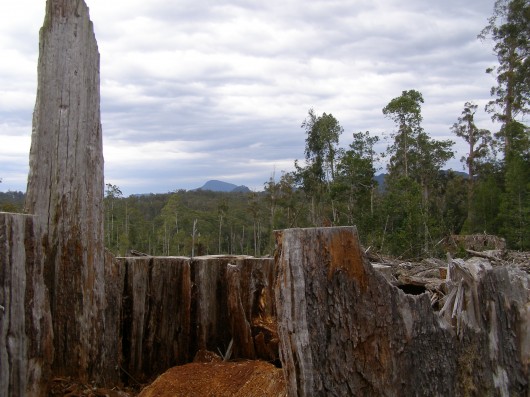 Forestry clearfell of old-growth in Tasmania’s Styx Valley
(Photo by Editor 20110928, free in public domain, click photo to enlarge) Forestry clearfell of old-growth in Tasmania’s Styx Valley
(Photo by Editor 20110928, free in public domain, click photo to enlarge)
.
More than two months (on 7th August 2011) after the landmark deal that promised to bring peace to Tasmania’s forests the protests – and the logging – continue unabated.
Funding for the struggling timber industry under the landmark $276 million Gillard-Giddings deal is starting to trickle out, but as yet not one tree has been saved!
Conservationists concede they may end up with nothing to show for 18 months of torturous negotiations, while many in the industry are sceptical that the promised peace will ever be achieved. The key decisions – on how many and which forests will be saved – are bogged down in difficult detail and alleged recalcitrance. Tasmania’s upper house, meanwhile, is lining up to sink the legislation needed to create the new national parks and reserves.
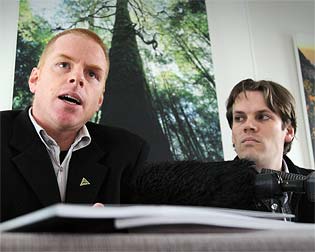 Environment Tasmania’s Phill Pullinger (right) with The Wilderness Society’s Vica Bayley Environment Tasmania’s Phill Pullinger (right) with The Wilderness Society’s Vica Bayley
.
A key conservationist and negotiator, Environment Tasmania director Phill Pullinger, concedes to Inquirer that events could conspire to see money flow to industry without one tree ever being saved.
“To be honest, it is a possibility,” says Pullinger, a Hobart doctor and former young Tasmanian of the year. “It has always been the case that the forest protection couldn’t be permanently delivered until the legislation goes through both houses of the Tasmanian parliament.”
.
That vote is a long way off, probably well into next year. The most immediate hurdle to overcome is a row over whether the state-owned Forestry Tasmania should be allowed to continue logging in 41 coupes (forest areas). All are within 430,000ha of forests set aside for “immediate” interim protection in the Gillard-Giddings deal of August 7, known as the Forests Intergovernmental Agreement or IGA.
Forestry Tasmania insists it needs to log in these coupes, a fraction of the total area, to maintain existing contracts to timber mills. Conservationists argue Forestry Tasmania could and should reschedule logging to less ecologically significant forests. The dispute was being sorted out by an independent rescheduling team appointed by state and federal governments. Inquirer has learned this process has gone badly for conservationists, with only seven of the 41 coupes able to be protected and five already logged. Forestry Tasmania and industry claim there simply is not time to do the rescheduling work – new roads, development of forest practices plans – necessary to shift to new areas quickly enough to meet existing timber contracts.
.
‘It is a fundamental problem that has weakened the (peace) process: you’ve got a government agency that is essentially working against the agreement. And the governments haven’t shown the stomach to pull the agency into line.’’
~ Phill Pullinger, Environment Tasmania, October 2011
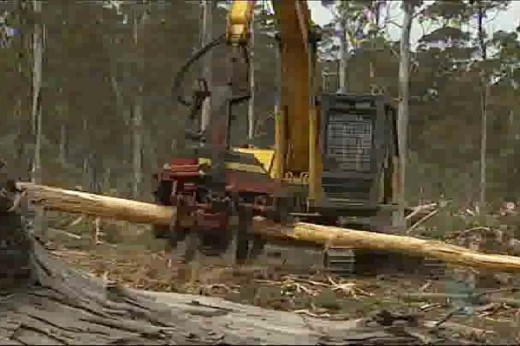
Conservationists claim this should have been done months ago, given that Forestry Tasmania was asked by the state government – its owner – to place a moratorium on logging in these forests in March.
“They (FT) have basically for 12 months now deliberately spun the wheels on that; there could easily have been a moratorium delivered six or nine months ago,” Pullinger says. “It is a fundamental problem that has weakened the (peace) process: you’ve got a government agency that is essentially working against the agreement. And the governments haven’t shown the stomach to pull the agency into line.”
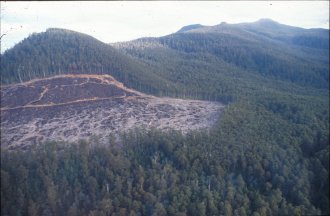
Crew-cutting pristine Tasmanian wilderness
.
This is rare intemperate talk from Pullinger, normally diplomatic and restrained as he tries to keep his constituency in the peace tent and the process on track.
It’s a sign things are not going well. Forestry Tasmania, a government business enterprise that reports to a board and is not necessary bound by ministerial direction, denies it has been dragging the chain. While it is the party with the most to lose – up to 572,000ha of native forest it manages for timber production – corporate relations manager Ken Jeffreys insists it is acting in good faith.
“Some people out there seem to think that FT has some maniacal glint in their eye and go out and harvest forests when it has no market because it has nothing better to do,” Jeffreys complains to Inquirer. “That is so far from common sense it’s hard to respond to.“
He insists Forestry Tasmania is happy to abide by the independent reschedulers’ verdict and points out that it has already rescheduled logging out of some contentious coupes. This fight over a handful of coupes has been holding up plans under the IGA for an overall immediate interim conservation agreement between the state, Forestry Tasmania and Canberra to protect the 430,000ha. Under the IGA, this interim agreement would protect those forests while an independent verification team determines the final size and location of the new permanent reserves.
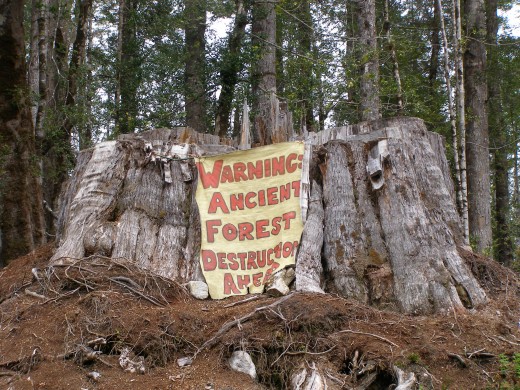 Ancient Myrtle Beech (Nothofagus cunninghamii)
chainsawed in the Upper Florentine Valley, Tasmania
(Photo by Editor 20110928, free in public domain, click photo to enlarge) Ancient Myrtle Beech (Nothofagus cunninghamii)
chainsawed in the Upper Florentine Valley, Tasmania
(Photo by Editor 20110928, free in public domain, click photo to enlarge)
.
IGA Independent Verification Team
.
The independent team, overseen by academic Jonathan West, will decide how much forest, of a larger 572,000ha nominated by green groups, is worthy of protection. West’s team will also test industry claims about how much timber it requires to meet existing contracts. Then it must decide how much forest can be protected while providing this resource. The job, which unrealistically is due to be completed by December 31, is the “forest wars” equivalent of deciding where exactly the boundaries of a Palestinian state should be drawn.
Conservation groups believe that most – if not all – of the 572,000ha can be protected, once a developing plantation resource is factored in.
.
Forestry Tasmania’s position
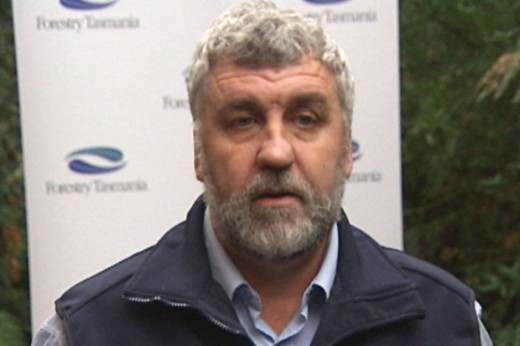
Forestry Tasmania chief, Bob Gordon
– what IGA? It’s logging business as usual to fill ‘orders’.
.
Forestry Tasmania stands by its modelling suggesting that no more than 300,000ha can be protected if it is to deliver on current timber contracts. Some in the industry believe only 250,000ha can be saved from the chainsaws. Neither of the industry figures is unlikely to be enough for conservationists, but may well be too much for Tasmania’s independent-dominated upper house. Several recent votes in the Legislative Council suggest it is opposed to the IGA and to more forest “lock-ups”. Its refusal to pass the reserves would leave conservationists relying on a federal-state conservation agreement to protect those forests.
While such an agreement would ban logging, it is legally uncertain if Forestry Tasmania could ignore this on the basis that it conflicts with its legislative or contractual obligations.
Jeffreys insists Forestry Tasmania would abide by any final agreement, subject to being able to meet those commitments – a big out if Forestry Tasmania decided to dig in for a battle.
.
Tony Burke’s position:
.
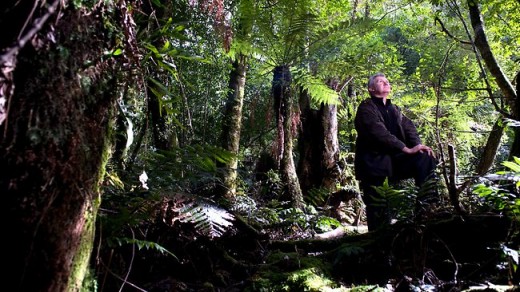 Federal Environment Minister Tony Burke
in Tasmania’s Wielangta forest, March 2011
(Photo by Matthew Newton, Source: The Australian ) Federal Environment Minister Tony Burke
in Tasmania’s Wielangta forest, March 2011
(Photo by Matthew Newton, Source: The Australian )
.
Despite the difficulties, federal Environment Minister Tony Burke remains confident he can pull off the kind of final “win-win” forest peace deal that has eluded so many of his predecessors. He tells Inquirer the alternative is a kind of mutually assured destruction, whereby the forests continue to fall as fast as the jobs.
The number of jobs in Tasmanian forestry has halved since 2008 from 6960 to 3460, due mainly to Japanese paper-makers boycotting woodchips sourced from native forests, Gunns exiting the industry in favour of a plantation-based pulp mill and as a result of the high Australian dollar.
“If you let the markets sort this one out without a co-ordinated strategy from state and federal government … then you end up with a terrible outcome for the Tassie economy … diabolical,” Burke says.
Initially as Forests minister and more recently as Environment Minister, Burke has been involved in the process from the beginning. The first in federal cabinet to twig to the potential to assist industry while securing a historic conservation outcome, he has repeatedly slipped quietly into Tasmania to do his own field work.
The former staffer to Graham Richardson has camped with greenies amid the giant eucalypts of the Styx Valley and toured sawmills and production forests. When the process has looked as if it were imploding, he has intervened with all sides to keep it on track. Inspired to join the ALP by landmark conservation battles such as the Daintree and Kakadu, Burke constantly stresses his desire to also secure a good outcome for jobs and industry.
He believes the (Tasmanian) Legislative Council will take a different view to new reserves when details are developed for a $120m federal regional development fund promised under the IGA. That money, to revitalise timber communities and diversify the Tasmanian economy, is contingent upon state parliament passing the new reserves legislation. No reserves; no $120m.
Burke, himself a former state upper house MP (in NSW), believes this cash for regions will ultimately win over the key 12 independent MLCs.
“Those MPs will have to look in the eyes of a whole lot of their constituents who are out of work and justify their actions,” he says. “I just don’t believe when it comes to it they’ll vote this down. This is the first time we have tried to deal with this issue with an independent process rather than a political fix. The irony this time is: can we stop politics from wrecking it, not from fixing it?”
He warns both sides will need to accept the outcome of the independent verification process. “They are honour-bound to accept the process – they created it,” he says.
This suggests Canberra will not be afraid to impose the verdict of the independent verification team if the two sides cannot embrace it – or at least an agreed variation of it. Such action may well see either side – timber or conservation – walk away.
Certainly, Pullinger won’t promise to accept the outcome if it is not embraced by both sides.
“If the independent verification group comes down and says … we are going to protect just a fraction of these forests … then – expert group or not – I don’t think anyone believes that is going to be able to deliver a lasting agreement.”
.
Editor:
The IGA deal is a deal is a promise. Why are Gillard and Giddings allowing Forestry Tasmania to renege on the deal by continuing to log these now protected native forests in Tasmania’s Styx Valley and southern forests. Why are Gillard and Giddings breaking their promise to Tasmanians?
IGA interim reserves are IGA interim reserves? The IGA offers millions in contractual compensation. So take the compensation Bob Gordon! You can’t have your compensation and interim reserves too!
Leave the bloody old growth alone!
 Prime Minister Julia Gillard, 2011
– do I really have to honour that forest deal?
(Photo: The Examiner) Prime Minister Julia Gillard, 2011
– do I really have to honour that forest deal?
(Photo: The Examiner)
.
Evidence of new logging despite Tasmanian Forests Agreement
.
[Source: ‘ Evidence of new logging despite Tasmanian Forests Intergovernmental Agreement requires urgent government action‘, by the Australian Conservation Foundation, 20110922, ^ http://www.thegreenpages.com.au/news/evidence-of-new-logging-despite-tasmanian-forests-intergovernmental-agreement-requires-urgent-government-action/]
.
Environment Tasmania, the Wilderness Society and the Australian Conservation Foundation have released a report assessing the status of logging in important native forests and photographs that show new logging activity in forest reserves prescribed by the Tasmanian Forests Intergovernmental Agreement (IGA).
“The settlement and retirement of Gunns’ native forest timber quotas has halved the demand for native forest timber from Forestry Tasmania, so there is no need or justification for logging within the forest reserve areas,” said Dr Phill Pullinger of Environment Tasmania.
“Wood supply for remaining sawmills can be provided from outside of the important native forests identified for protection,” Dr Pullinger said.
“Aerial photographs taken in late August and last week show Forestry Tasmania continues to log inside the 430,000 hectares of unique and important forests identified for immediate protection in the IGA,” said Vica Bayley of the Wilderness Society.
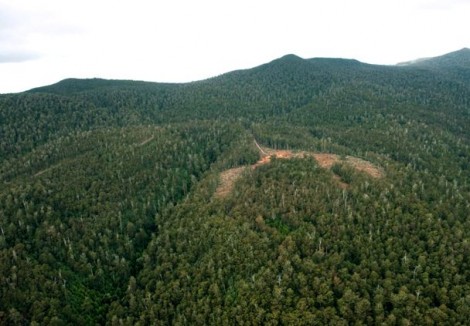
“In fact, our report and the new photos show Forestry Tasmania has not rescheduled logging outside this area and has even commenced logging new coupes since the IGA was signed.
“While we are encouraged to see progress on key components of the intergovernmental agreement — including the retirement of Gunns’ wood quota, funding for timber workers and contractors and the independent verification group — we have seen no progress on halting logging inside the nominated forest reserve areas,” Mr Bayley said.
“Environment groups again call on the state government to honour the agreement it has signed by directing Forestry Tasmania to declare the nominated forests as informal reserves and immediately appointing an independent expert to undertake the rescheduling,” said Denise Boyd of the Australian Conservation Foundation.
The report released today is part of environment group signatories’ ongoing commitment to implementing the IGA and will provide governments with verified, accurate information to help achieve the forest protection outcomes of the IGA. The state government must now ensure delivery of the critical plank of the IGA – forest protection.
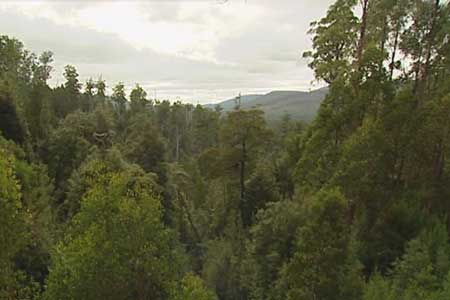
“We have seen no progress on halting logging inside the nominated forest reserve areas.”
~ Vica Bayley, The Wilderness Society
.
Forest protest continues in Mount Mueller Forest, Styx Valley (Tree Sit, Day 7)
.
Check out The ObserverTree protest website:
^http://observertree.org/
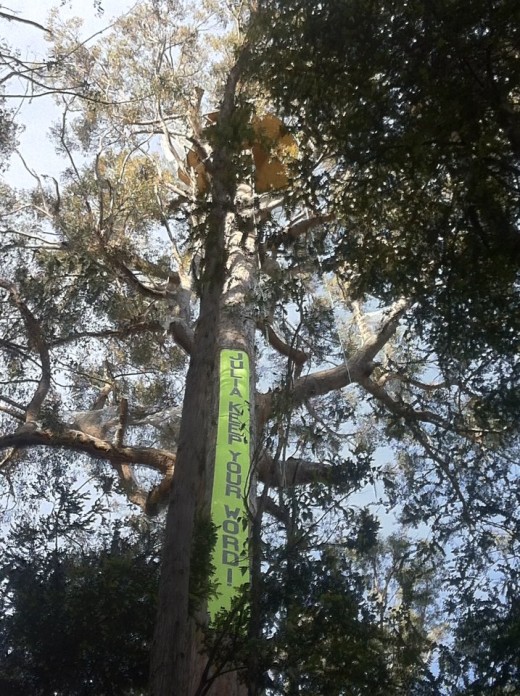
.
Tags: breaking promise, clearfell, Crew-cutting pristine Tasmanian wilderness, Environment Tasmania, Forestry Tasmania, IGA, interim reserves, Julia Gillard, Lara Giddings, Myrtle Beech, Nothofagus cunninghamii, Prime Minister Julia Gillard, Styx Forest, Styx Valley, Tasmania, Tasmanian Forests Intergovernmental Agreement, The ObserverTree, Tony Burke, Upper Florentine Valley
Posted in Tasmania (AU), Threats from Deforestation, Threats to Wild Tasmania | No Comments »
Add this post to Del.icio.us - Digg
Wednesday, December 7th, 2011
The following article was ‘borrowed’ from CanDoBetter.net under the title ‘The Tarkine Wilderness under threat‘ by author Vivienne Ortega dated 20111207:
.
‘Tasmania’s Tarkine Wilderness Endangered!’
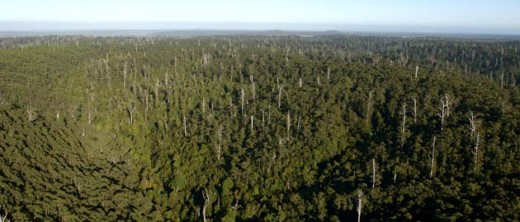 The Tarkine region is located in the north-west of Tasmania. The area encompasses 447,000 hectares of wilderness including the Southern Hemispheres largest single tract of temperate rain forest, a wild coastline with an extraordinary wealth of Aboriginal Cultural Heritage sites. It’s the habitat for over 50 threatened species. The extensive rainforests, beautiful river gorges, buttongrass mountain tops, flowering heathlands and long wild beaches combine to make the Tarkine one of the world’s great treasures. The Tarkine region is located in the north-west of Tasmania. The area encompasses 447,000 hectares of wilderness including the Southern Hemispheres largest single tract of temperate rain forest, a wild coastline with an extraordinary wealth of Aboriginal Cultural Heritage sites. It’s the habitat for over 50 threatened species. The extensive rainforests, beautiful river gorges, buttongrass mountain tops, flowering heathlands and long wild beaches combine to make the Tarkine one of the world’s great treasures.
These rainforests are important for their flora which has links to the ancient continent of Gondwana, and for their lichens and fossils which help tell the story of Australia’s ancient flora and its evolution. The Tarkine is a sensitive region rich in mega-diversity. It’s one of the world’s last remaining temperate rain-forests, the home of the Tasmanian Devil and many other precious species.
.
Tarkine National Heritage a must
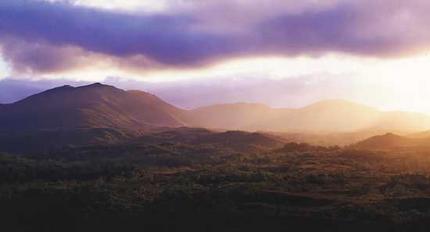 How many places on Earth still look like this?
What an incredible asset of eco-experience (not dodgy eco-tourism) wild Tasmania offers the world’s discerning explorer? How many places on Earth still look like this?
What an incredible asset of eco-experience (not dodgy eco-tourism) wild Tasmania offers the world’s discerning explorer?
.
The Tarkine must be put on the National Heritage List. The heritage assessment of The Tarkine will help ensure that the heritage values are considered in decision-making, so heritage protection is balanced with the social and economic aspirations of the Tasmanian community. Short-term economic benefits should not be at the expense of the un-quantifiable value of ancient woodlands, rugged coastlines, and forest habitat destruction. Mining companies like Venture Minerals are desperate to exploit the minerals beneath Tasmania’s environmentally significant Tarkine area.
 Enter the Tin Men Enter the Tin Men
.
Demand for metals superior to Tasmania’s ecology?
.
Chinese demand for base metals such as gold, iron, tin, zinc, lead, copper is at an all time high, and this would mean logging, pollution, roads, and heavy traffic destroying the landscape and pristine rivers.
Environment Minister Tony Burke was called on to immediately include the Tarkine on the emergency National Heritage Listing amid concerns about the impact on the Tasmanian devil population of a revised tourist road project. He denied that he made a promise to do so. His predecessor, Peter Garrett, first gave the Tarkine wilderness a one-year emergency listing, which Mr Burke let expire. Since then he has let a British mining company test drill in the area. Mr Burke says the new plan for a tourist road is not the same as the original 132-kilometre loop road plan that was subject to a now lapsed emergency listing. One road is not similarly destructive an another? Mining and road proposals threaten to carve up Tasmania’s unprotected the Tarkine wilderness area, local defenders say.
Venture Mineral’s Mt Lindsay tin, tungsten and iron mining proposal, coupled with the revival of the controversial Tarkine link road proposal, should have given Mr Burke grounds to reinstate Tarkine’s emergency National Heritage listing. Heritage listings would not stop mining, but developments would have to pass more rigorous and critical environmental tests.
The Mount Lindsay tin project is the largest of several mines planned around the Tarkine in an emerging new Tasmanian environmental battle. The Tarkine National Coalition said up to nine new open cut mines are in development there. Venture Minerals predict $1 billion in revenue, with more than 500 jobs in construction and 200 in operation. Surely the threats of mining are enough reasons for an emergency heritage listing for the Tarkine?
Mr Burke says the principle that a heritage listing automatically locks out all development is wrong. He says with or without a heritage listing, environmental protection remains. “Developments” and “protection” are inherently contradictory. Mr Jordan who heads the Tarkine National Coalition says Mr Burke’s decision to lift the heritage listing means other mining companies will not be scrutinised as closely as Beacon Hill Resources. The whole area should be protected as a national park.
The interests of miners are being placed above the Minister’s obligations to the environment. All three proposed mining projects will have secured Commonwealth environmental permits during the 18 month period he had at his disposal, allowing them to avoid scrutiny against National Heritage criteria. They will also be allowed to continue exploration drilling and associated access roading without need for Commonwealth assessments.
The mining will cause havoc to the pristine condition of the area. There is nothing “sustainable” now. It’s just window-dressing. What about the costs and long term damage of these industries and jobs? Mr Burke is supposed to represent the environment, not the mining industries. As with his population strategy, that come to nothing, he is now abrogating his duty to protect one of the last temperate rain-forest areas in the world.
.It is wrong to destroy sacred and holy places to plunder their riches, and the same applies to Nature’s sacred places.
 A proud colonial relic of a Tasmanian old growth forest raped, pillaged and plundered
…and today colonial logger descendants, hanging on to the past, are paupers.
(Photo by editor 20110928, free in public domain – click to enlarge, then click to enlarge again) A proud colonial relic of a Tasmanian old growth forest raped, pillaged and plundered
…and today colonial logger descendants, hanging on to the past, are paupers.
(Photo by editor 20110928, free in public domain – click to enlarge, then click to enlarge again)
.
.
Please email a demand to the ultimate decision maker of our temporary time:
Australia’s current Environment Minister: Tony.Burke.MP@aph.gov.au
.
Sunday, December 4th, 2011
“..this awe-inspiring, largely unknown part of Australia – a wilderness that has survived, virtually untouched, for over 65 million years from its Gondwana heritage, but which is today under increasing threat from Man.”
.
~ Robert Purves, June 2010, in Foreword of the book ‘The Tarkine’, edited by Ralph Ashton and published by Allen & Unwin, [Available at ^http://www.allenandunwin.com/default.aspx?page=94&book=9781742372846]
.
 The Tarkine’s mystical beauty of an ancient Giant Myrtle (Nothofagus cunninghammii) The Tarkine’s mystical beauty of an ancient Giant Myrtle (Nothofagus cunninghammii)
.
Urgent press releases from the local champions trying to save The Tarkine:
.
.
‘New threats to the Tarkine’
.
(Source: The Wilderness Society, Tasmania, ^http://www.wilderness.org.au/regions/tasmania/new-threats-to-the-tarkine)

We all know the Tarkine is an environmental jewel – but when mining companies look at this special place, they see the glint of valuable metals instead. Gold, iron, tin, zinc, lead, copper – you name it and chances are it can be found in the mineral-rich bedrock beneath the Tarkine.
With Australia in the grip of an extraction bonanza, and Chinese demand for base metals at an all time high, the pressure to open up the Tarkine to mining is building. So far, 12 mines have been proposed for the Tarkine over the next two years, along with 56 licences for mineral exploration in the area. If even a fraction of these mines go ahead, this wild land of rugged coastline, pristine rivers and forested hills could be compromised – criss-crossed with exploration tracks and roads and dotted with waste dumps, pits and trenches.
The Tarkine is of huge environmental significance. It is one of the largest remaining tracts of temperate rainforest on earth, and home to a huge variety of species including:
- Tasmanian devils
- Tasmanian wedge- tailed eagles
- Spotted-tailed quolls
- Southern bell frogs
- White goshawks
- Giant freshwater lobster
- Eastern barred bandicoots
- Orange-bellied parrots
- and the Huon pine.
.
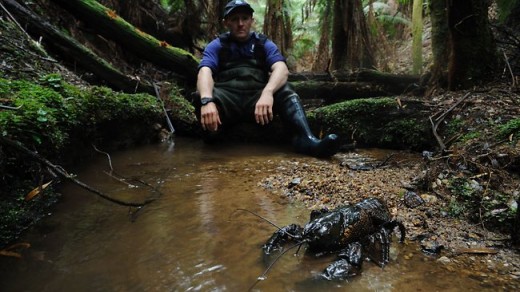 Tasmania’s Giant Freshwater Lobster (Astacopsis gouldi)
It is found only in northern Tasmanian streams (particularly in The Tarkine) and rivers flowing into Bass Strait.
It is found nowhere else in the world, yet is threatened by illegal fishing, land clearing and forestry.
(Source: Matthew Denholm, Tasmania Correspondent, The Australian, 20111109) Tasmania’s Giant Freshwater Lobster (Astacopsis gouldi)
It is found only in northern Tasmanian streams (particularly in The Tarkine) and rivers flowing into Bass Strait.
It is found nowhere else in the world, yet is threatened by illegal fishing, land clearing and forestry.
(Source: Matthew Denholm, Tasmania Correspondent, The Australian, 20111109)
[Read Recovery Plan]
.
Environmental jewel
The Tarkine’s wild, rugged coastline – there’s no land between this point and the South American coast – boasts some of the cleanest air in the world. Because of these values (above ground), the Tarkine has long been the subject of a community-driven National Park proposal. In addition, in 2010, a report by the Australian Heritage Commission recommended that 430,000 hectares of the Tarkine be granted National Heritage status.
But Environment Minister Tony Burke has refused to implement this recommendation, claiming a need for further assessment and consultation. For decades, environmentalists have been working to protect the Tarkine. Some campaigns have been lost – like the road to nowhere in the mid 1990s – others have been won. Now, with the Tasmanian Forest Agreement progressing, it looks like the area may at last be protected from logging.
.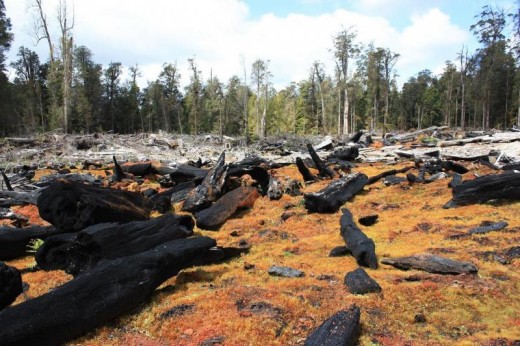 Logging and ‘scorched earthing’ of old-growth rainforest in The Tarkine
(October 2009, Environment Tasmania) Logging and ‘scorched earthing’ of old-growth rainforest in The Tarkine
(October 2009, Environment Tasmania)
.
But mining remains as a threat in this pristine region.
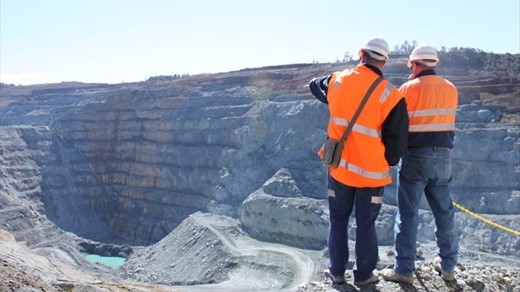 Savage River Open Cut Mine in the north of The Tarkine Savage River Open Cut Mine in the north of The Tarkine
.
It’s not hard to predict what will happen over the coming months: mining companies will pressure the Tasmanian Government to allow these mines to go ahead, dressing their arguments up in the usual disguise by claiming that mining is essential for jobs.
But putting industry ahead of the environment is an approach that has failed for decades and a new approach is needed. The Wilderness Society is involved with a coalition of groups calling for the creation of a Tarkine National Park.
With your support, the Wilderness Society will be standing up for an Australia that values the Tarkine not for the metals that can be extracted by destroying it, but for the precious environmental qualities that it has when left intact.
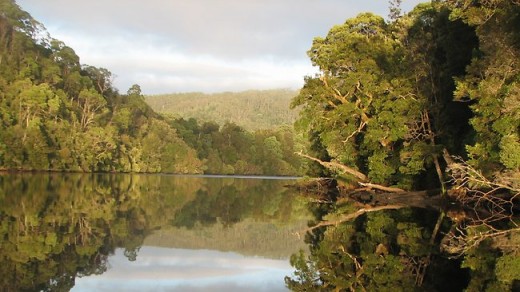
.
‘Burke’s broken promise misleads the public’
.
(by Scott Jordan, Campaign Coordinator, Tarkine National Coalition, 20111202, Tasmanian Times online newspaper, ^http://tasmaniantimes.com/index.php?/weblog/article/burkes-broken-promise-misleads-the-public/)

‘Tarkine National Coalition has reacted angrily to the latest chapter in Environment Minister Tony Burke’s campaign of misinformation regarding the Tarkine National Heritage assessment. The Minister made comment on ABC Mornings (936 Tasmania) that he did not have in his possession any report from the Australian Heritage Council supporting a permanent listing of the Tarkine.
This is at odds with our reading of the Australian Heritage Council report from September 2010 which supported the permanent listing of 433,000 hectares it had assessed as having National Heritage Values. Minister Burke has refused to publicly release this report, despite FOI requests from the ABC last year.
“The Minister is clearly failing in his responsibilities here, and is spinning mistruths to try and cover up his complicity in promoting mining in the Tarkine wilderness reserves,” said Tarkine National Coalition spokesperson Scott Jordan.
The Minister received this report two months before allowing the Tarkine’s Emergency National Heritage Listing to lapse. He then sent the AHC back to reassess the area, with a substantial budget cut and no capacity to complete the work before 2013. This will effectively shepherd up to ten new mine proposals through an EPBC process that cannot in the absence of a listing, legally consider impacts on National Heritage Values such as wilderness, rainforest, geological significance (fossil sites and karst systems), aesthetic character, Indigenous or European cultural heritage.
This mirrors the strategy applied by the Minister at the controversial Brighton By-pass in southern Tasmania and at James Price Point in northern WA, where once EPBC assessments were underway, a National Heritage Listing was applied that could have no legal effect on those ongoing assessments.
Independent advice from Andrew Macintosh, Associate Director of the ANU Centre for Climate Law and Policy confirms that the AHC report does in fact refer to a permanent listing, and advises that the AHC’s terms of reference only allow it to report on whether an area has National Heritage Values and prevents it from making ‘qualified’ or ‘preliminary’ findings. The correspondence from Mr Macintoshcan be downloaded below..
“It becomes impossible to have reasonable dealings with a Minister who won’t stick to the rules, and won’t tell the truth”. “The Minister must immediately release the Australian Heritage Council’s Tarkine report from September 2010”.
.
Emergency National Heritage Listing
The TNC and partner groups (WWF, Australian Conservation Foundation, The Wilderness Society, Tasmanian Conservation Trust, Environment Tasmania and North West Environment Centre) resubmitted a Emergency National Heritage Listing nomination last week, triggered by the threats to National Heritage Values of the Mount Lindsay and other mining proposals.

The resubmitting of the Tarkine Road proposal by the Tasmanian Government called into play a promise made by Minister Burke last December that if the Tarkine Road was resubmitted, that he would immediately re-list the Tarkine. The Minister has failed to deliver on this promise.
“The failure to reapply a Tarkine Emergency National Heritage Listing in response to the Tarkine Road referral clearly shows this Minister’s contempt for the responsibilities of his office, and clearly tells us that any promises he makes are worthless”.
“The key difference between this proposal and the former proposal is not the alterations to the route, but the fact that a mining company now needs this route for transporting product to ports”.
.
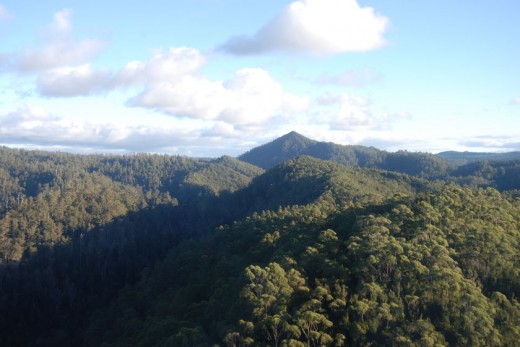
.
.
‘Burke places money and mines before Tarkine’
.
by Senator Christine Milne, Tasmanian Times online newspaper, ^http://tasmaniantimes.com/index.php?/weblog/article/burkes-broken-promise-misleads-the-public/]
.
Federal Environment Minister, Tony Burke, must explain why he will allow the assessment of mining proposals to occur in the Tarkine before acting on advice before him to permanently heritage list the region, Australian Greens Deputy Leader, Christine Milne said today.
“Minister Burke today claimed on ABC local radio to have no information leading to the emergency heritage listing of the Tarkine, but failed to mention a report buried in his department recommending the Tarkine be listed.
“The Environment Minister is playing into the hands of mining companies, who are no doubt jubilant of the 2013 deadline given to the Australian Heritage Council to determine whether permanent heritage listing should be put in place.
“By 2013, all ten of the mining proposals will be submitted to the department and any subsequent heritage listing will have no effect on their operations. The wilderness, geological and cultural values of the Tarkine will not be assessed.
“It is like putting on a seatbelt after your car has crashed.
“Minister Burke’s job has moved from a focus on natural and heritage values to one of being solely concerned with bleeding monetary value from the places he is supposed to protect.
“Peter Garrett placed emergency heritage listing on the Tarkine following the state government’s previous attempt at building a road, and now, with a similar application before him, as well as ten mining applications that will be seriously impinged by such a listing, we have Minister Burke reneging on his promise to heritage list the region should another road proposal be made.
“This ongoing, seven year process to determine heritage listing the Tarkine has become an embarrassment to Australia whose governments persistently fail to recognise the value of this natural jewel.
.
“Minister Burke has everything at his disposal for immediately placing the Tarkine on the National Heritage list.
Act now, Minister Burke, before these mines have your name all over them.”

Tasmania as seen by miners – exploitative ‘below-ground’ values
.
Selected comments readers of Tasmanian Times:
.
by Barnaby Drake (20111202):
“The key difference between this proposal and the former proposal is not the alterations to the route, but the fact that a mining company now needs this route for transporting product to ports”.
‘Is it not just as I predicted? All infrastructure for these mining companies will be paid for by us. Here the original estimate was for $24 Million as a starters. Expect the real cost to be dramatically understated so that they can get their approval before announcing the usual blow-out! And that’s just the start of it. That also means that the Tourism budget will take the hit, but strangely, Forestry will also be able to us this road as the Tarkine is no longer protected. It will then be discovered by TasPorts that they need to upgrade their port facilities somewhere in the West to benefit the local inhabitants and they require another Sqillion Dollars and of course, create a couple of thousand jobs, etc.
Hallelujah! The economy has been saved. Your pensions are safe. A new mining tax will see us all happy and prosperous and MP’s will be able to have their blocked salary increases paid. A replay of the famous once Gunns proposals.
All we need now is an education bus to train the kiddies for the future. Utopia!’
.
by John Hayward (20111202):
‘The Minister would see his responsibility as being to himself, his party, and to their major political contributors. His apparent dishonesty, or ignorance, is merely a consequence of these priorities.’
.
by Russell Langfield (20111202):
‘Can anyone name a promise Environment Minister Burke has kept, or a decision being made which favoured the environment over business interests?’
.
Salamander (20111202):
‘Burke likes to make out he is a man of the people, and responds when he gets enough signals from the people to act for the environment. Yesterday he was complaining about the hijacking of his twitter account by tweets about the Tarkine – but still he won’t do what the people want. Seems to me we have a puppet whose strings are completely controlled by corporations.’
.
by Pete Godfrey (20111203):
‘There is no money for hospitals, police, mobile phones for police, anything that is good for people, but there is always money available for Forestry and Mining. From what I can recall every mine venture that has received grants from the government has failed. All we ever get back is the privelege of cleaning up the mess and a hole in the ground. Part of the Tarkine have already been destroyed comprehensively by Forestry Tasmania, it is time to protect the rest from both of these rapacious subsidy collectors.’
.
by Pete Godfrey (20111203):
‘Unless you count building a road for Mining and Logging access to the area as a grant. I do.
What will happen is that he industry will start up, then say “oh it is not viable without some subsidies” then we put our hand in the the till and hand over heaps of money. Just like all the other mining ventures on the west coast. The companies accept the money then close the mine down not long after.
You can guarantee that the government will pay in the end.
We will pay for the new “mining and forestry road”
We will upgrade port facilities.
We will pay for road damage and bridge damage. Which is what the original Tarkine loop road proposal was about, it was to rebuild two bridges that have washed away before, the Tayatea bridge being one of them.
We may not hear of incentive grants to attract the miners but you can bet that a certain minister from the west will be handing grants out like lollies.’
.
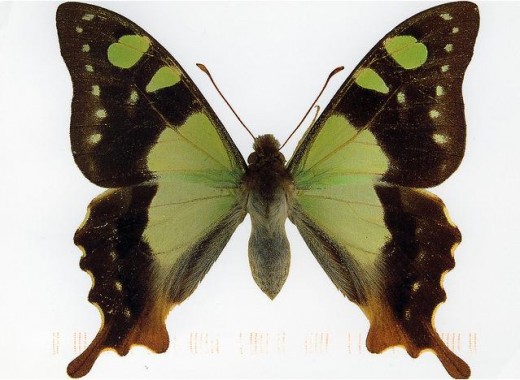 Maclays Swallowtail (Graphium Macleyanum), a native to The Tarkine
© Photo by Marja-Liisa, Helsinki (‘mliisa’s photostream’ on flickr, AU-2100 from Lynette,
^http://www.flickr.com/photos/25816219@N00/1921054368/ Maclays Swallowtail (Graphium Macleyanum), a native to The Tarkine
© Photo by Marja-Liisa, Helsinki (‘mliisa’s photostream’ on flickr, AU-2100 from Lynette,
^http://www.flickr.com/photos/25816219@N00/1921054368/
.
‘If the Tarkine were to be joined to the world heritage area, a vast reserve would be created, stretching from just a few kilometres south of Tasmania’s north coast all the way to its south-western extremity.
If this were to happen, it would, in my opinion, be among the top half-dozen natural areas remaining in the world. And properly managed, it would bring wealth to Tasmanians into the foreseeable future.’
.
~ Tim Flannery, contribution in ‘The Tarkine‘ (2010), edited by Ralph Ashton, and published by Allen & Unwin.
.
Tags: Australian Heritage Council, Giant freshwater lobster, National Heritage, National Park proposal, old growth forest, Savage River Open Cut Mine, save the Tarkine, scorched earthing, Tarkine National Coalition, Tarkine National Heritage, Tarkine National Park, Tarkine’s Emergency National Heritage Listing, Tasmania, Tasmanian Government, The Tarkine, Tony Burke
Posted in Tasmania (AU), Threats from Deforestation, Threats from Mining, Threats from Road Making, Threats to Wild Tasmania | No Comments »
Add this post to Del.icio.us - Digg
Thursday, December 1st, 2011
Corporate Tin Miner:
“We will continue to be aggressive explorers with multiple rigs focused on exploration for the foreseeable future.”
.
~ Venture Minerals (corporate tin miner from Perth), in its Mt Lindsay-Investor Presentation,
(Nov 2011), p.31
.
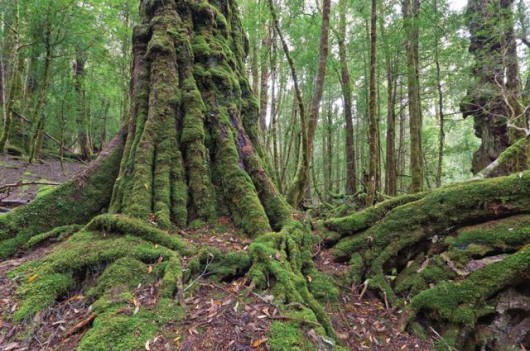 ‘The Tarkine’ – 430,000 hectares of ancient Tasmanian forest ‘The Tarkine’ – 430,000 hectares of ancient Tasmanian forest
Tasmania’s ancient Myrtle/Sassafras forest – threatened by loggers, logger ‘adventure tourism’, roads and now bloody tin mining!
[Photo by Peter Walton, Tasmanian Expeditions – Photo Gallery on The Tarkine, ^http://www.tasmanianexpeditions.com.au/index.php?section=photo_highlights&id=285742]
.
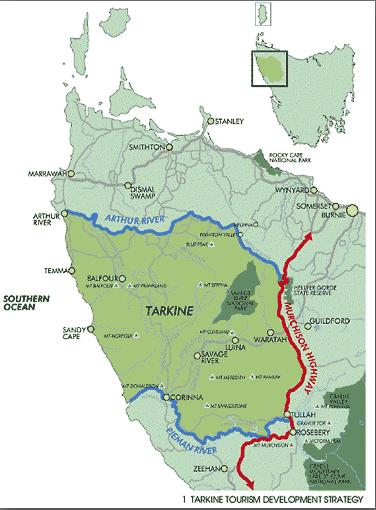 Cradle Coast Authority (CCA), North West Tasmania’s map
as part of a tourism development strategy. Cradle Coast Authority (CCA), North West Tasmania’s map
as part of a tourism development strategy.
.
A bid to restore emergency National Heritage protection to the Tarkine wilderness in Tasmania’s north-west has been launched by environmentalists to head off a ”Pilbara-style” mine in the rainforest. Several conservation groups lodged the nomination with the Environment Minister, Tony Burke, hoping he will count heritage values in his impending decision on the big Venture Minerals’ Mount Lindsay open cut project.
Emergency listings of The Tarkine have been granted four times since 2004!
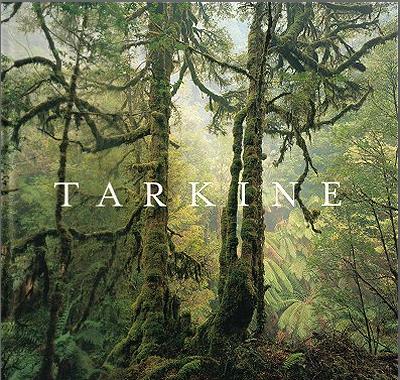 Moss-clad Sassafras (Atherosperma moschatum) trees in the Arthur River catchment near Waratah, Tarkine, Tasmania
(Photo © Ted Mead November 2003)
[Front Cover of the 2004 book, ‘Tarkine‘ edited by Ralph Ashton, and available from publishers Allen and Unwin,and just purchased by The Habitat Advocate.
Available at: ^http://www.allenandunwin.com/default.aspx?page=94&book=9781742372846]
Moss-clad Sassafras (Atherosperma moschatum) trees in the Arthur River catchment near Waratah, Tarkine, Tasmania
(Photo © Ted Mead November 2003)
[Front Cover of the 2004 book, ‘Tarkine‘ edited by Ralph Ashton, and available from publishers Allen and Unwin,and just purchased by The Habitat Advocate.
Available at: ^http://www.allenandunwin.com/default.aspx?page=94&book=9781742372846]
.
…but that’s not how the ‘Tin Men‘ see The Tarkine…
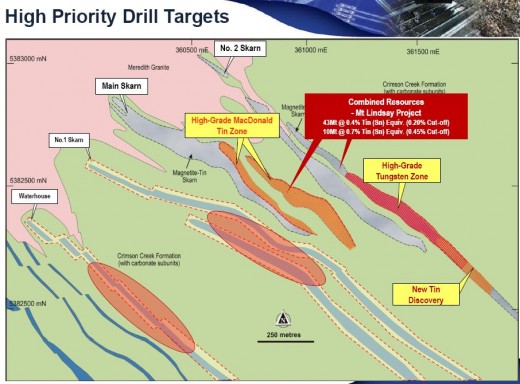 This is how the ‘Tin Men‘ see the Tarkine… for its tin and tungsten.
(Source: Venture Minerals’ Mt Lindsay-Investor Presentation, Nov 2011) This is how the ‘Tin Men‘ see the Tarkine… for its tin and tungsten.
(Source: Venture Minerals’ Mt Lindsay-Investor Presentation, Nov 2011)
.
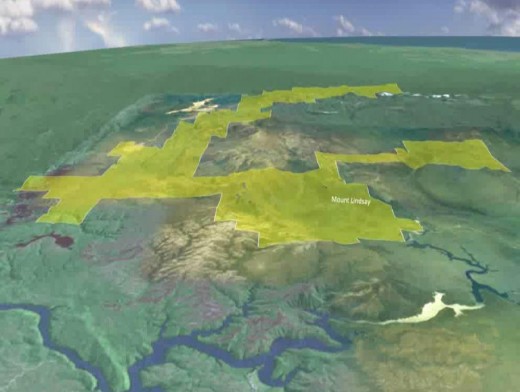 …and this is how the ‘Tin Men’ see the Tarkine… for the vast mining lease area they are happy to exploit and lay to waste. …and this is how the ‘Tin Men’ see the Tarkine… for the vast mining lease area they are happy to exploit and lay to waste.
(Source: Venture Minerals’ Mt Lindsay-Investor Presentation, Nov 2011)
.
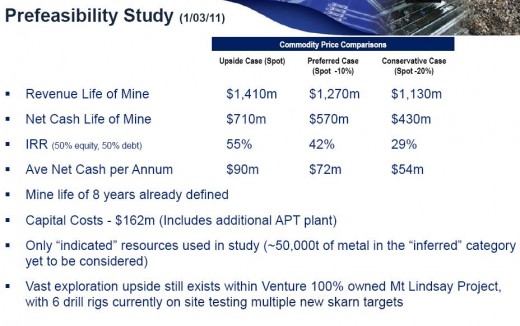 …and this is how the Tin Men see the Tarkine – for its ‘Super Mining Profits’ … 30 to 55% return! …and this is how the Tin Men see the Tarkine – for its ‘Super Mining Profits’ … 30 to 55% return!
(Source: Venture Minerals’ Mt Lindsay-Investor Presentation, Nov 2011)
.
The Mount Lindsay tin project is the largest of several mines planned around the Tarkine in an emerging new Tasmanian environmental battle. The Tarkine National Coalition said up to nine new open cut mines are in development there. Mr Burke allowed a previous emergency listing for the Tarkine to lapse a year ago when he said plans for a road through the wilderness were dropped. Environment groups objected because of what they said were increasing threats from mining.
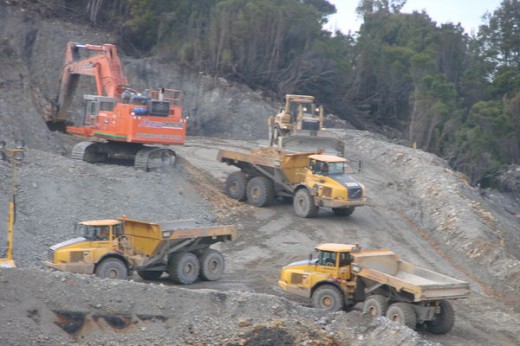 Corporate Miner ‘Metals X’ getting well stuck into a Tarkine rainforest hillside at nearby Mount Bischoff Corporate Miner ‘Metals X’ getting well stuck into a Tarkine rainforest hillside at nearby Mount Bischoff
.
The 430,000-hectare Tarkine region is undergoing a protracted assessment for future listing by the Australian Heritage Council. But because the wilderness now lacks any listing, Mr Burke is unable to consider heritage values in an approval of the Mount Lindsay mine under the Environment Protection and Biodiversity Conservation Act. Instead, his decision is likely to focus on protection of endangered species such as the Tasmanian Devil. The Tarkine is the wildest remaining stronghold for healthy devils, stricken across the rest of the island by a deadly facial cancer.
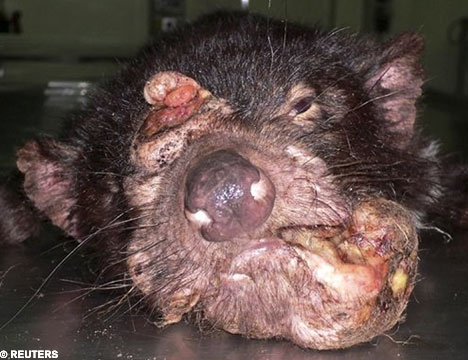 The Tarkine is a refuge for healthy Tasmanian Devils to avoid the genocidal tumour disease
..but what could heartless commercial ‘Tin Men’ care?
Think of the ‘Super Mining Profits’ … 30 to 55% return! The Tarkine is a refuge for healthy Tasmanian Devils to avoid the genocidal tumour disease
..but what could heartless commercial ‘Tin Men’ care?
Think of the ‘Super Mining Profits’ … 30 to 55% return!
.
The Tarkine National Coalition spokesman Scott Jordan said yesterday:
”Companies, including Venture, are using the removal of the heritage protections to ramp up exploration activities including roading and drilling that are having a significant effect on the values of the area.”
.
The coalition was joined by the World Wildlife Fund, the Australian Conservation Foundation and The Wilderness Society in seeking the listing. An Australian National University environmental law specialist, Andrew Macintosh, said emergency listings had been granted four times since 2004, but Mr Burke was not compelled to respond to the request. In a statement, Mr Burke did not respond directly to the emergency listing request, but said he would continue meeting with different groups on issues surrounding the heritage listing of the Tarkine. [Editor’s note: in fact there has been one emergency National Heritage listing (Dec 2009 – Dec 2010), one National Heritage nomination (2004), three emergency National Heritage nominations (Nov 2009, Mar 2011 and Nov 2011), and two AHC recommendations (2003 and Sep 2010)… so what’s it bloody take to get the message through?]
.
[Source: ‘ Call for heritage listing of the Tarkine to head off tin mine‘, Sydney Morning Herald, 20111119, ^ http://www.smh.com.au/national/call-for-heritage-listing-of-the-tarkine-to-
head-off-tin-mine-20111118-1nndq.html]
.
.
‘Jobs, jobs, jobs’ justification – but all for mainlanders, foreigners and short-termers
.
Typically, this miner (Venture Minerals) relies on the standard jobs justification to exploit, dig up, pollute and destroy the Tarkine Wilderness for tin. Venture Mineral is promising 700 jobs! But of those , 500 jobs involve construction – so short term fly ins from the mainland and overseas only during construction phase. The remaining 200 jobs are promised for the mine’s operations. But miners don’t train locals. This is not about Tasmanian jobs. These 200 jobs will be sourced from similar mines on the mainland and indeed from overseas all on on Federal Labor’s 457 Visa (Australian worker displacement) Scheme. Just look at OZ Minerals at Rosebery.
457 Visas: ‘..for employers who would like to employ overseas workers to fill nominated skilled positions in Australia, to employ overseas workers for a period of between one day and four years.’
[Source: ^http://www.immi.gov.au/skilled/skilled-workers/sbs/]
.
Venture Minerals is Perth-based at 181 Roberts Road Subiaco, another West Australian corporate miner exploiting Tasmania and taking the profits offshore. Venture Minerals forecasts $1 billion in revenue but it won’t go to Tasmanians. It will go back to West Australia and to its rich mine shareholders. Typically mining is eco-rape, pillage and plunder – wam, bam, thank you mam, then pissing off back to where one came, leaving another tin moonscape like Mount Bischoff.
Look at the mining legacies across Tasmania left as moonscapes:
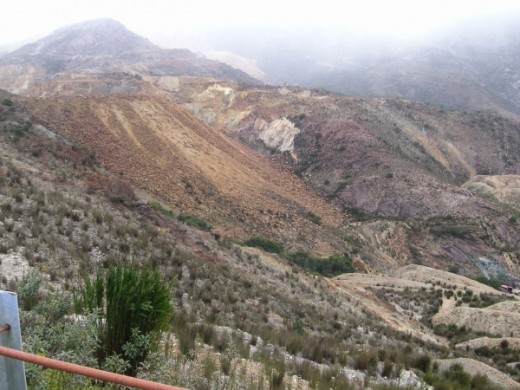 Nearby Mount Bischoff Tin Mine – wam, bam, thank you mam! Nearby Mount Bischoff Tin Mine – wam, bam, thank you mam!
.
- Kara Mine in Hampshire
- Mount Lyle’s sulphuric moonscape
- Henty Mine
- Briseis Mine at Derby
- Pioneer Mine on Bradshaws Creek
- Anchor Mine on Blue Tier
- Gladstone Mine
- Coles Bay Mine
- Ben Lomond Mine
- St Paul’s River Mine
- Flinders Island Mines
- Mount Heemskirk
- Mount Balfour
- Renison Bell
- Stanley River
- Mount Cleveland
- Cox Bight
- Melaleuca
- etc
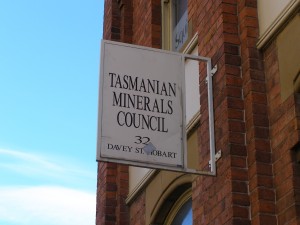
And of course the Tasmanian Minerals Council backs mining in The Tarkine. And of course it opposes national heritage listing of the Tarkine. The Tasmanian Minerals Council is only about the financial bottom line, exploitation of ore and perpetuating its own existence.
 The Tasmanian Minerals Council claims that there are “already enough layers of protection across the Tarkine region, where about 80% of the land has been put in multiple use reserves that allow mining“. The Tasmanian Minerals Council claims that there are “already enough layers of protection across the Tarkine region, where about 80% of the land has been put in multiple use reserves that allow mining“.
What ‘layers of protection’? If 80% of the Tarkine is reserved form mining, how can that be for protection? – for protection of mining profits and royalties perhaps.
So Tony Burke, if you’re not to pre-occupied with resolving the future of the Murray-Darling, what time are you allocating for Tasmania’s ancient Myrtle forests?
.
.
.
‘Tasmania’s Tarkine wilderness is one of the world’s largest temperate rainforests.
This vast expanse is a wilderness wonderland of wild rivers, dramatic coastal heathlands, button grass plains, bare mountains, ancient Huon pines, giant eucalypts and myrtles and extraordinary horizontal scrub.
It is home to rare and endangered birds – like the Orange-bellied parrot and the White goshawk – and countless animals such as the Eastern pygmy possum. This superbly illustrated book captures the beauty of this unique wilderness.’
.
[Source: ^http://www.andrewisles.com/all-stock/publication/tarkine]
.
Orange-bellied Parrot
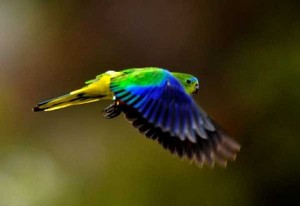 ‘Here at Melaleuca, six days’ walk from the nearest road,
such moments of peace are typically broken by bird calls,
including the distinct buzzing of the orange-bellied parrot’.
.
[Source: ‘Scientists Race To Rebuild Parrot Population’, by Peter Ker, Sydney Morning Herald, 20110207, ^http://www.globalanimal.org/2011/02/07/scientists-race-to-rebuild-parrot-population/29032/] ‘Here at Melaleuca, six days’ walk from the nearest road,
such moments of peace are typically broken by bird calls,
including the distinct buzzing of the orange-bellied parrot’.
.
[Source: ‘Scientists Race To Rebuild Parrot Population’, by Peter Ker, Sydney Morning Herald, 20110207, ^http://www.globalanimal.org/2011/02/07/scientists-race-to-rebuild-parrot-population/29032/]
.
Current status:
‘The Orange-bellied parrot (Neophema chrysogaster) is one of 18 birds listed as endangered under the Tasmanian Threatened Species Protection Act 1995. It is also listed as endangered under the Federal Act and has the dubious honour of being one of the most endangered birds Australia wide.
Why is it endangered? The Orange-bellied parrot is endangered because it is so rare (only 200 birds left) and its habitat is quickly disappearing.
.
There are only about 50 breeding pairs of this bird left!
..but what could heartless commercial ‘Tin Men’ care?
Think of the ‘Super Mining Profits’ … 30 to 55% return!
.
‘…It is a breeding endemic of Tasmania, which means that it only breeds in Tasmania. In fact it only breeds in one place in Tasmania and that is in our Southwest National Park. It arrives here in summer, nesting in eucalypt tree hollows adjacent to the parrot’s feeding grounds of extensive coastal buttongrass plains.’
.
[Source: http://www.dpiw.tas.gov.au/inter.nsf/webpages/bhan-54g3c5?open]
.
Tags: 457 visas, Cradle Coast Authority, Environment Minister, high priority drill targets, Melaleuca, Metals X, Mount Lindsay, Orange-bellied Parrot, Pieman River, super mining profits, Tarkine Tourism Development Strategy, Tarkine Trails, Tarkine wilderness, Tasmania, Tasmanian Devil, Tasmanian Minerals Council, The Tarkine, tin man, tin men, tin mine, Tony Burke, tungsten mine, Venture Minerals, wam bam thank you mam
Posted in Birds (Australian), Tasmania (AU), Tasmanian Devils, Threats from Mining, Threats to Wild Tasmania | 8 Comments »
Add this post to Del.icio.us - Digg
|
|
 Orange-Bellied Parrot (Neophema chrysogaster)
Critically endangered and breeds only in Tasmania, Australia
[Source: Photo by John Harrison, in article ‘Threat of extinction demands fast and decisive action’, 20120724, by Tara Martin, published in The Conversation,
^http://theconversation.com/threat-of-extinction-demands-fast-and-decisive-action-7985]
Orange-Bellied Parrot (Neophema chrysogaster)
Critically endangered and breeds only in Tasmania, Australia
[Source: Photo by John Harrison, in article ‘Threat of extinction demands fast and decisive action’, 20120724, by Tara Martin, published in The Conversation,
^http://theconversation.com/threat-of-extinction-demands-fast-and-decisive-action-7985]
 Beverley Four Mile Uranium Mine
550km north east of Adelaide
Beverley Four Mile Uranium Mine
550km north east of Adelaide
 Australia’s recent Environment Ministers, respectively Peter Garrett and Tony Burke
Both Babyboomer Middle-Aged Men
Invariably in business, in politics, Babyboomer Middle-Aged Men
are the demographic drivers of ecological destruction across the planet.
Australia’s recent Environment Ministers, respectively Peter Garrett and Tony Burke
Both Babyboomer Middle-Aged Men
Invariably in business, in politics, Babyboomer Middle-Aged Men
are the demographic drivers of ecological destruction across the planet.
 The 100 tonne coal ship the ‘Shen Neng 1’ which went aground on 5th April 2010, while negotiating the Great Barrier Reef
The ship destroyed 3km of the coral Douglas Shoal which it “completely flattened” and “pulverised” marine life. The marine park authority’s chief scientist, Dr David Wachenfeld, expressed concerned also about the toxic heavy metal anti-fouling paint scraping off the hull.
[Source: ‘Three kilometres of Great Barrier Reef damage, 20 years to mend’, 20100414, by Tom Arup, The Age newspaper,
^http://www.theage.com.au/environment/three-kilometres-of-great-barrier-reef-damage-20-years-to-mend-20100413-s7p8.html]
The 100 tonne coal ship the ‘Shen Neng 1’ which went aground on 5th April 2010, while negotiating the Great Barrier Reef
The ship destroyed 3km of the coral Douglas Shoal which it “completely flattened” and “pulverised” marine life. The marine park authority’s chief scientist, Dr David Wachenfeld, expressed concerned also about the toxic heavy metal anti-fouling paint scraping off the hull.
[Source: ‘Three kilometres of Great Barrier Reef damage, 20 years to mend’, 20100414, by Tom Arup, The Age newspaper,
^http://www.theage.com.au/environment/three-kilometres-of-great-barrier-reef-damage-20-years-to-mend-20100413-s7p8.html]
 Tony Burke – the only grey haired Babyboomer in this photo
His demographic is responsible for the worst destruction of ecology across the Planet,
because the Nature-compromising values of males in this generation were formed when Nature was still considered plenty and its exploitation a God-given gospel.
Tony Burke’s values are wrong, inappropriate and his powerful decisions irreversible.
Tony Burke – the only grey haired Babyboomer in this photo
His demographic is responsible for the worst destruction of ecology across the Planet,
because the Nature-compromising values of males in this generation were formed when Nature was still considered plenty and its exploitation a God-given gospel.
Tony Burke’s values are wrong, inappropriate and his powerful decisions irreversible.
 On the brink of extinction: the Bridled Nailtail Wallaby
[Source: Photo by Kate Geraghty, Dead and dying: our great mammal crisis’, 20121117, by Tim Flannery, The Age newspaper,
^http://www.theage.com.au/national/dead-and-dying-our-great-mammal-crisis-20121116-29hi9.html]
On the brink of extinction: the Bridled Nailtail Wallaby
[Source: Photo by Kate Geraghty, Dead and dying: our great mammal crisis’, 20121117, by Tim Flannery, The Age newspaper,
^http://www.theage.com.au/national/dead-and-dying-our-great-mammal-crisis-20121116-29hi9.html]
 Species Extinction on Peter Garrett’s Watch
<< The Australian Government will invest $1.5 million to begin the rescue of Christmas Island’s ecosystem, including a mission to capture the last remaining Pipistrelle bats for captive breeding. “Volunteers and help from the Australasian Bat Society will be invaluable in this capture effort.” “My top priority now is to prevent any further extinctions and to restore the island’s environmental health,” Mr Garrett said.>>
A year later the critically endangered Christmas Island Pipistrelle (Pipistrellus murrayi) was declared extinct.
Species Extinction on Peter Garrett’s Watch
<< The Australian Government will invest $1.5 million to begin the rescue of Christmas Island’s ecosystem, including a mission to capture the last remaining Pipistrelle bats for captive breeding. “Volunteers and help from the Australasian Bat Society will be invaluable in this capture effort.” “My top priority now is to prevent any further extinctions and to restore the island’s environmental health,” Mr Garrett said.>>
A year later the critically endangered Christmas Island Pipistrelle (Pipistrellus murrayi) was declared extinct. Gilbert’s Potoroo – only 40 left
Gilbert’s Potoroo – only 40 left
 Southern Corroborree Frog (Pseudophryne corroboree)
Endemic to yet critically endangered in the Australian Alps.
Southern Corroborree Frog (Pseudophryne corroboree)
Endemic to yet critically endangered in the Australian Alps. Margaret River burrowing crayfish (Engaewa pseudoreducta)
[© Photo by Quinton Burham]
With only two known populations, the Margaret River burrowing crayfish is highly endangered.
Even one of these may no longer exist, as there have been no sightings since 1985.
The threats are almost all attributed to human activity.
Land clearing is the biggest danger, as crayfish habitat can be eroded or contaminated by farming, mining and urban development.
Feral pigs also damage habitat.
[Source: ^http://www.australiangeographic.com.au/journal/australias-most-endangered-species.htm]
Margaret River burrowing crayfish (Engaewa pseudoreducta)
[© Photo by Quinton Burham]
With only two known populations, the Margaret River burrowing crayfish is highly endangered.
Even one of these may no longer exist, as there have been no sightings since 1985.
The threats are almost all attributed to human activity.
Land clearing is the biggest danger, as crayfish habitat can be eroded or contaminated by farming, mining and urban development.
Feral pigs also damage habitat.
[Source: ^http://www.australiangeographic.com.au/journal/australias-most-endangered-species.htm]
































































